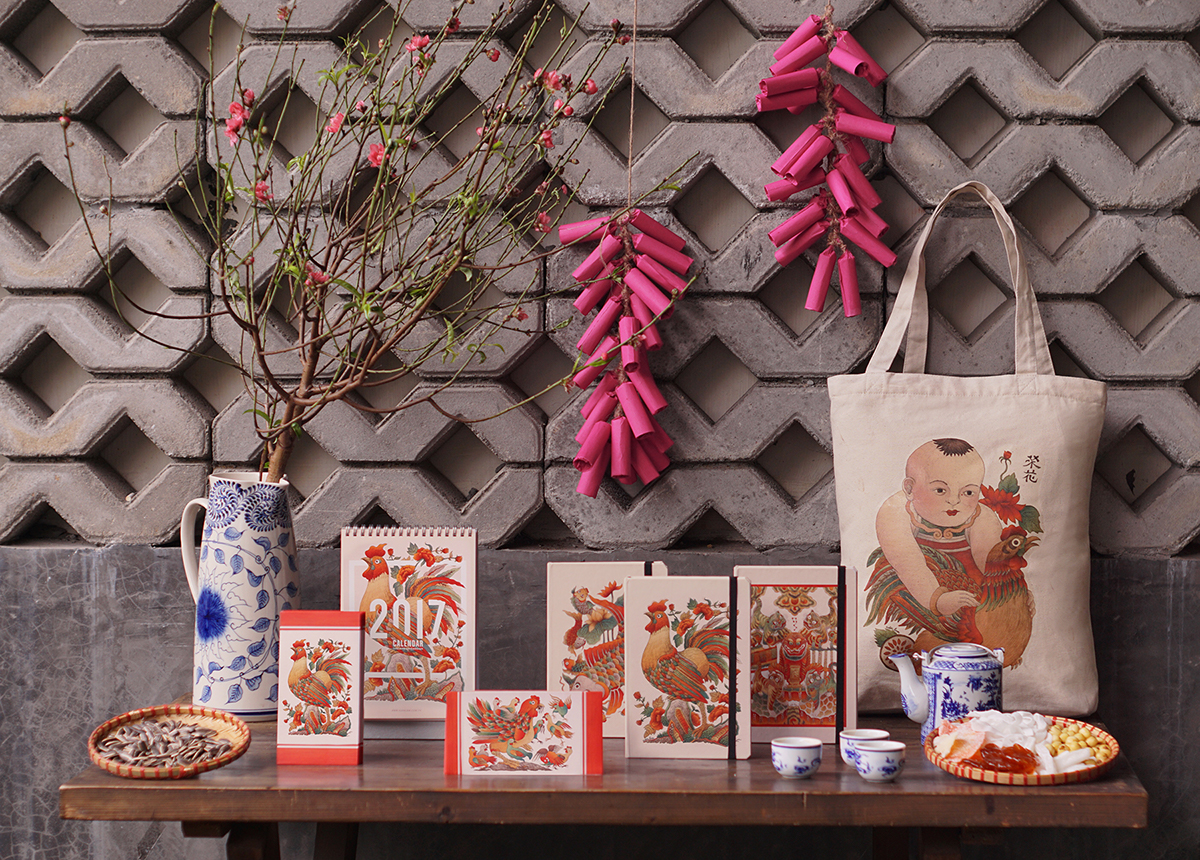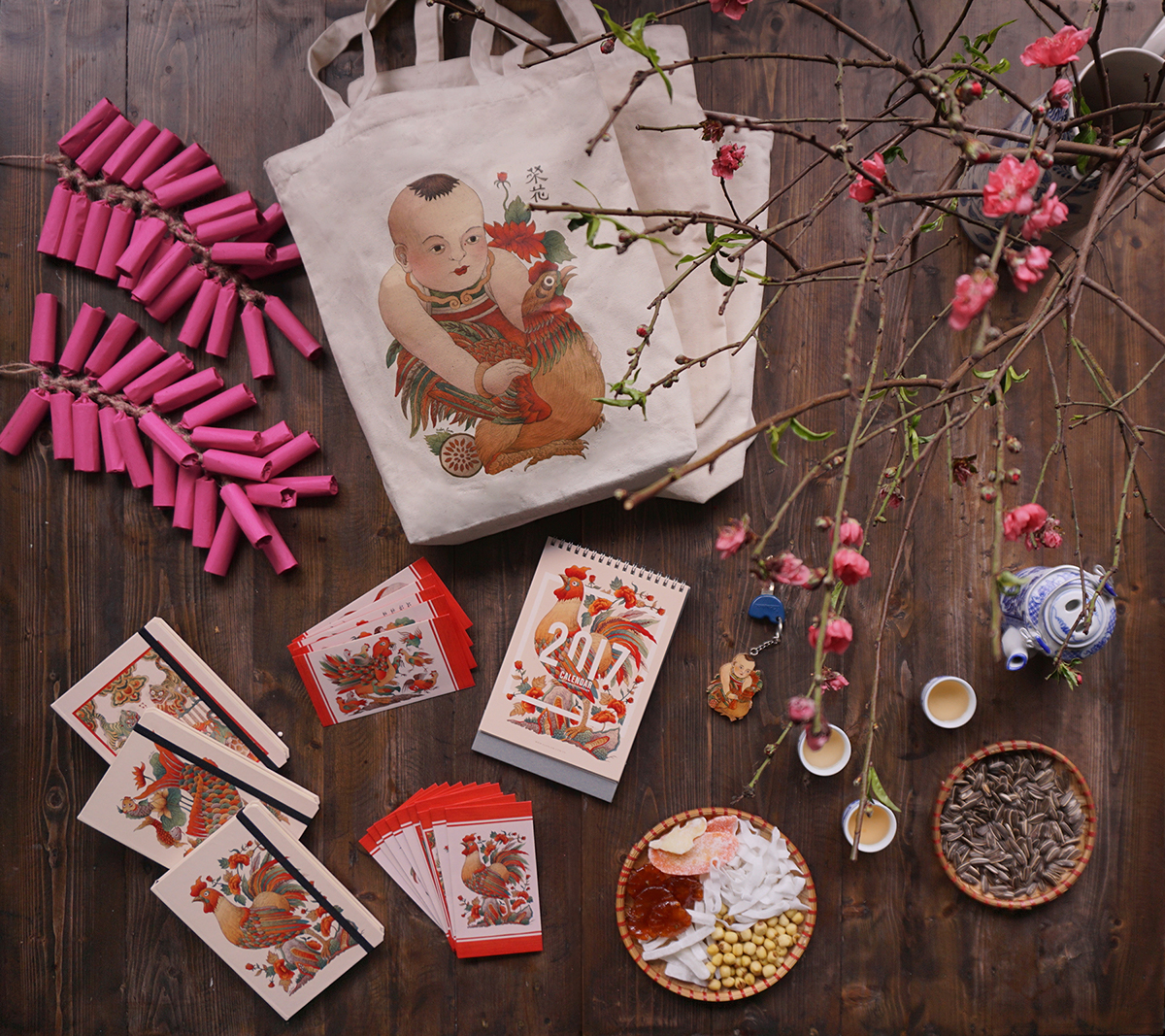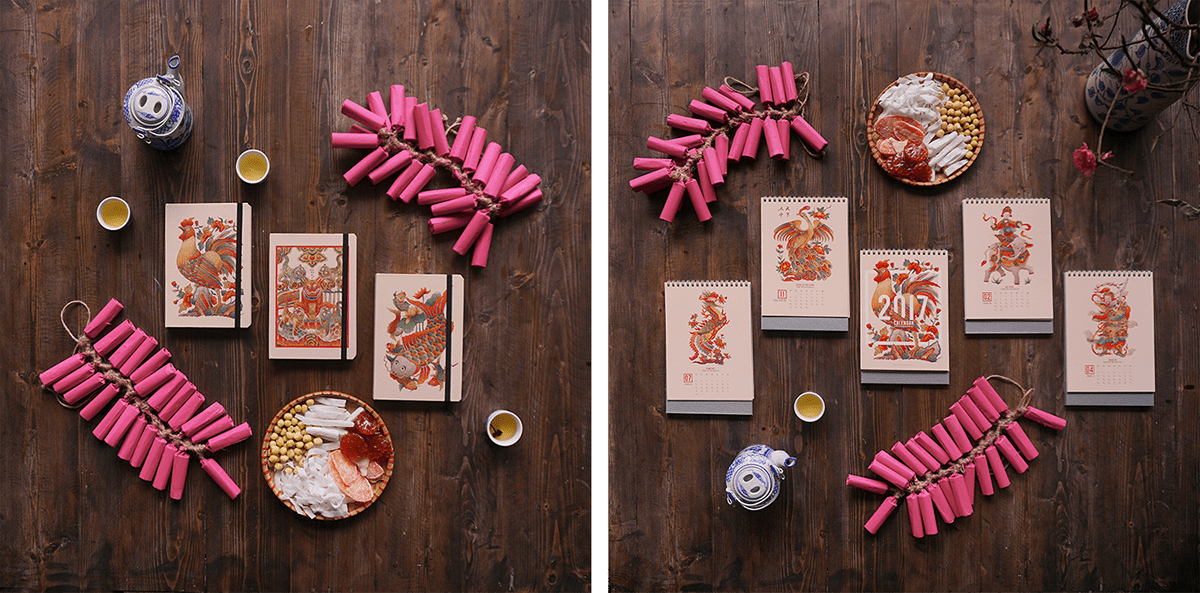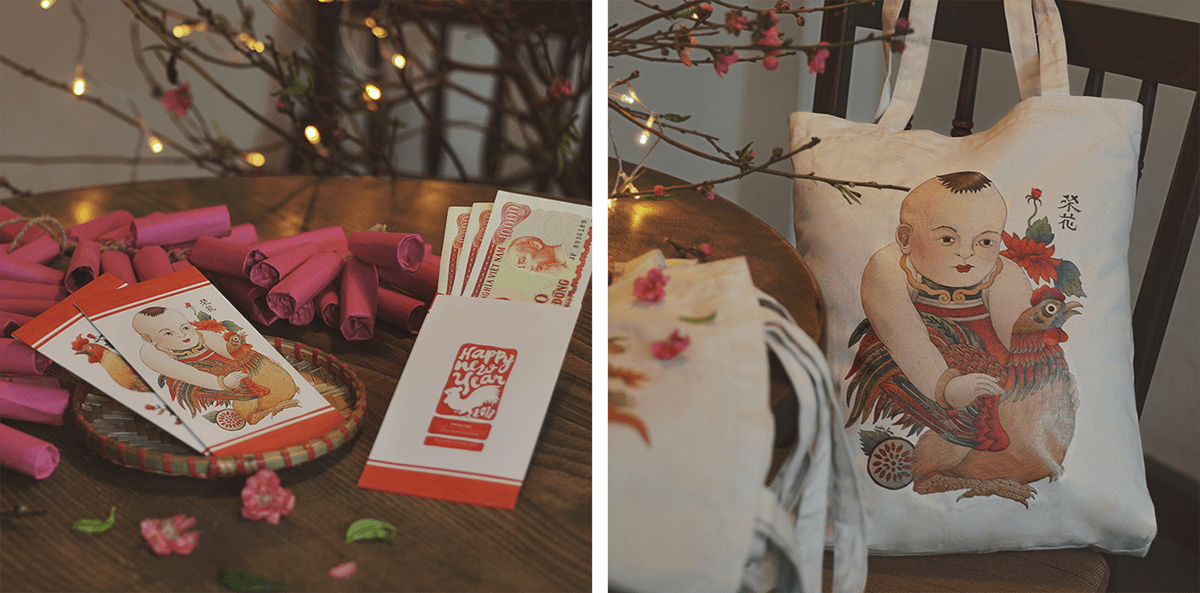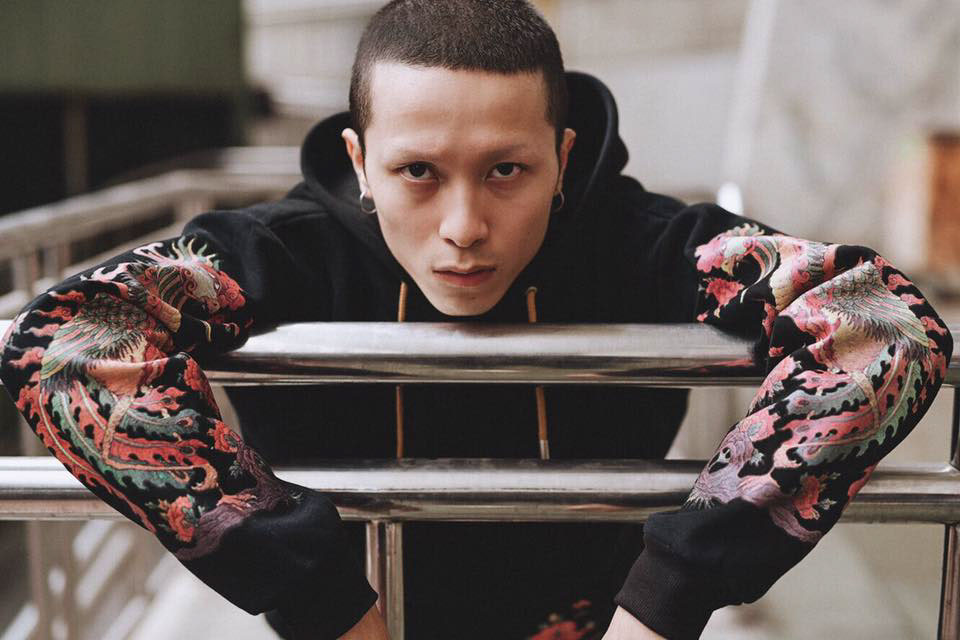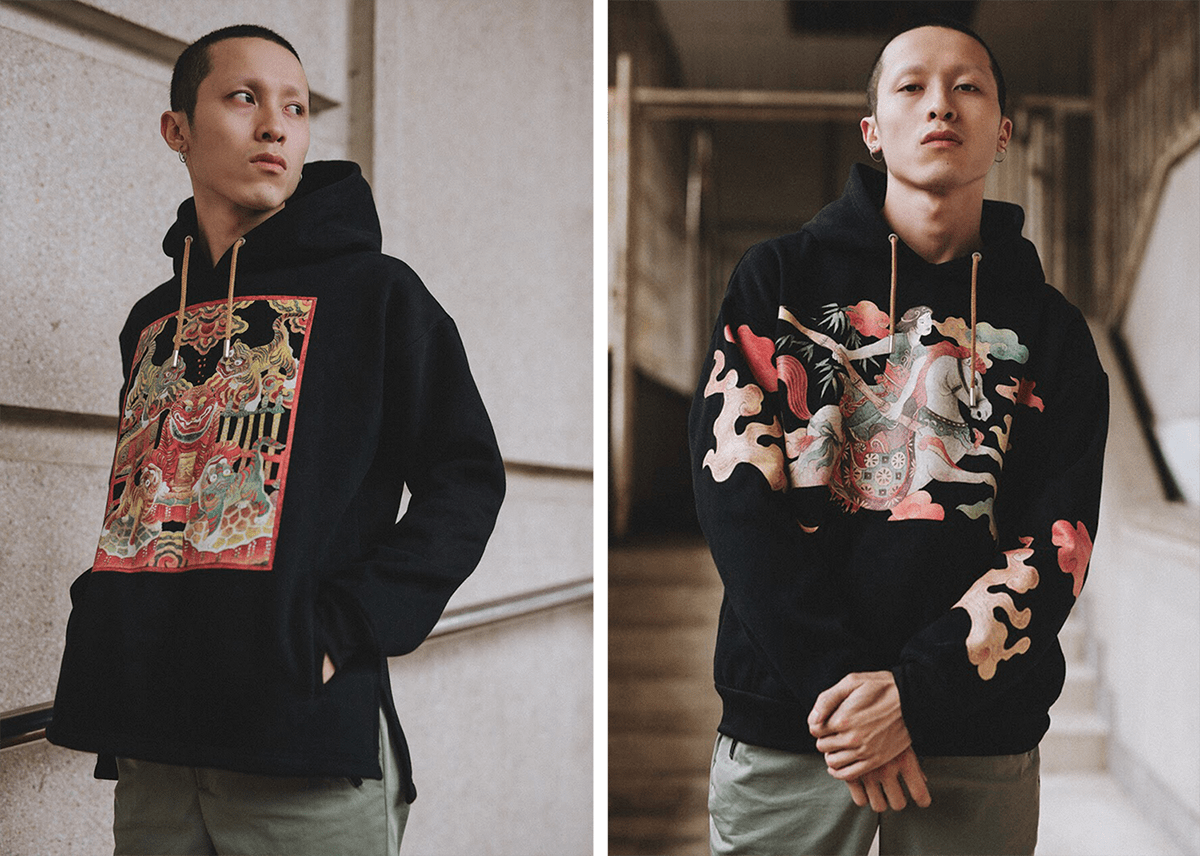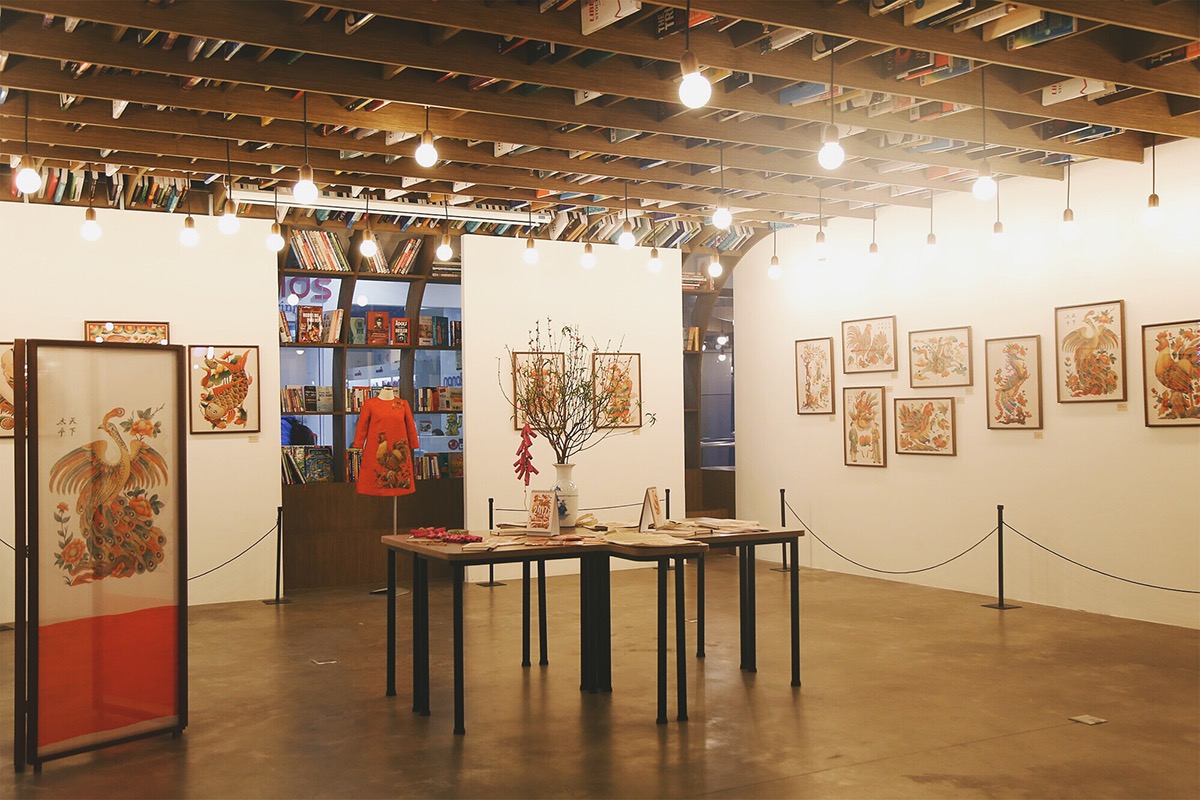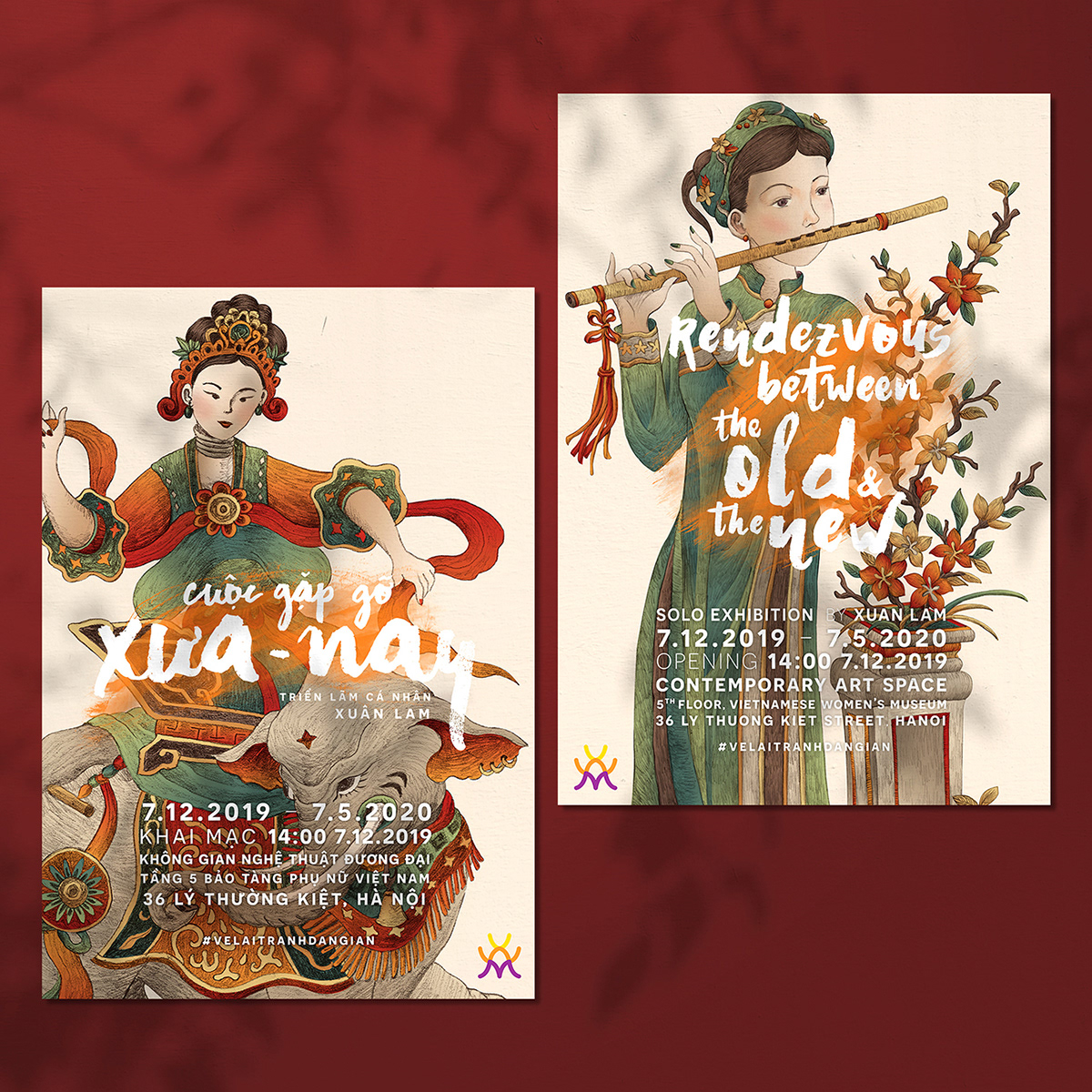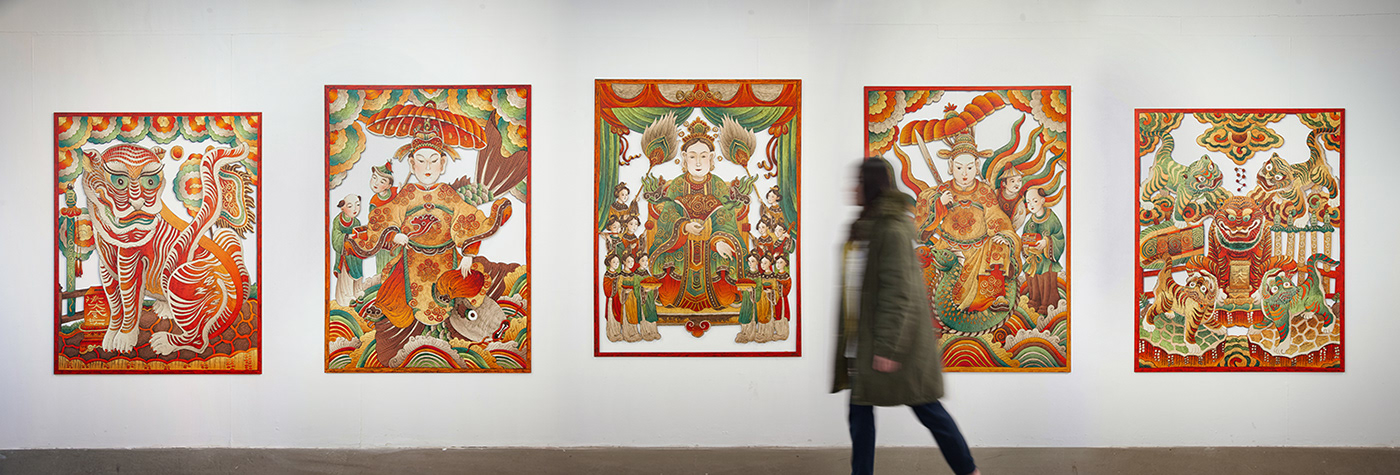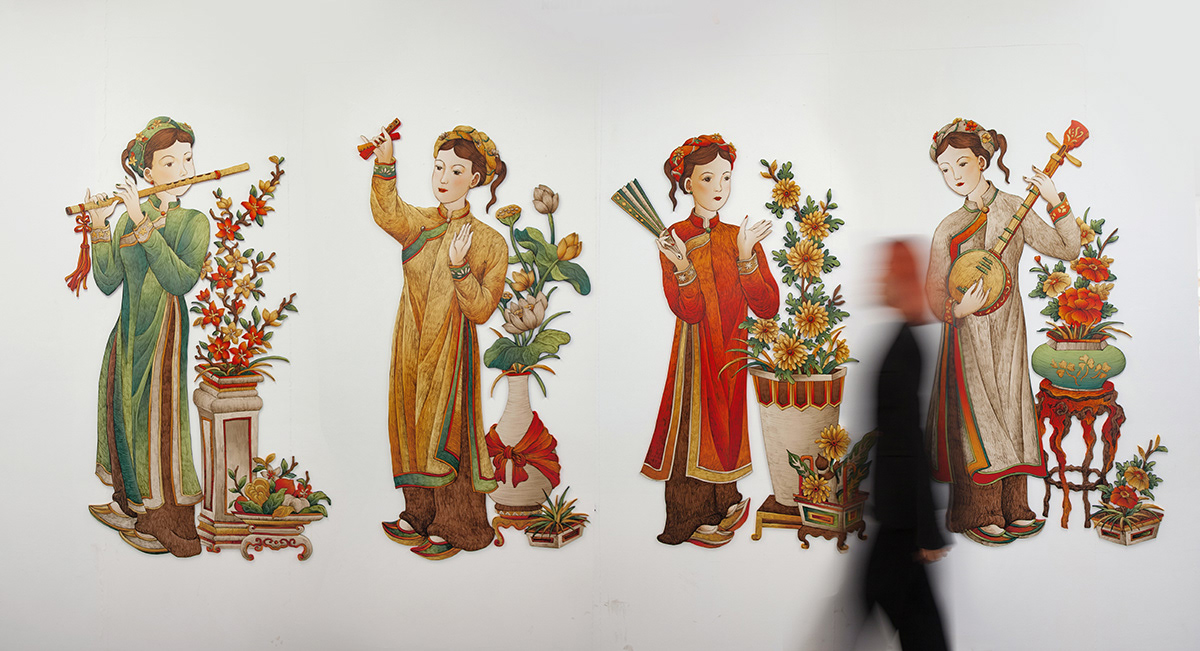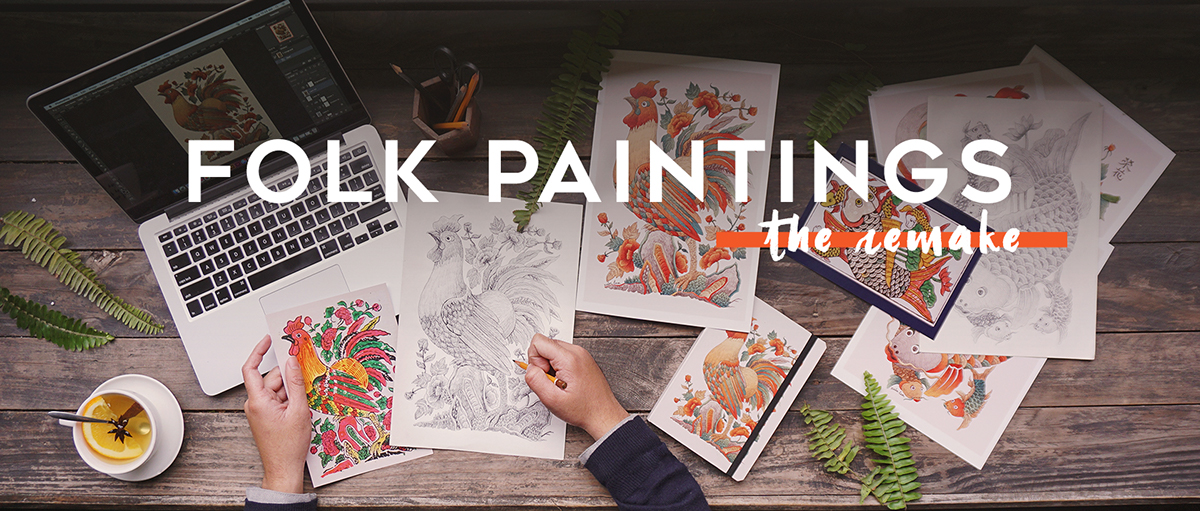

Folk Paintings – the Remake, a project conducted in 2016, features the modern renditions of 20 Vietnamese folk paintings. Besides, in the project, the folk paintings are also applied in the daily products. On the occasion of the Lunar New Year of the Rooster, I organized an exhibition with a view to showcasing the project. As a tradition of the ancient Vietnamese, Lunar New Year is also the time when people make their way to the Tet markets and buy the folk paintings to decorate their homes.

Twenty paintings featured in the project are inspired by the Dong Ho Folk Woodcut Paintings, Hang Trong Paintings and Religious Paintings from the Northern Provinces. The structures of these paintings are largely preserved, with a touch of additional details to make it livelier. The major tones used in Dong Ho Paintings such as yellow, green, red, brown and the color of “dó” paper are also employed in combination with the gradient technique of graphic design.
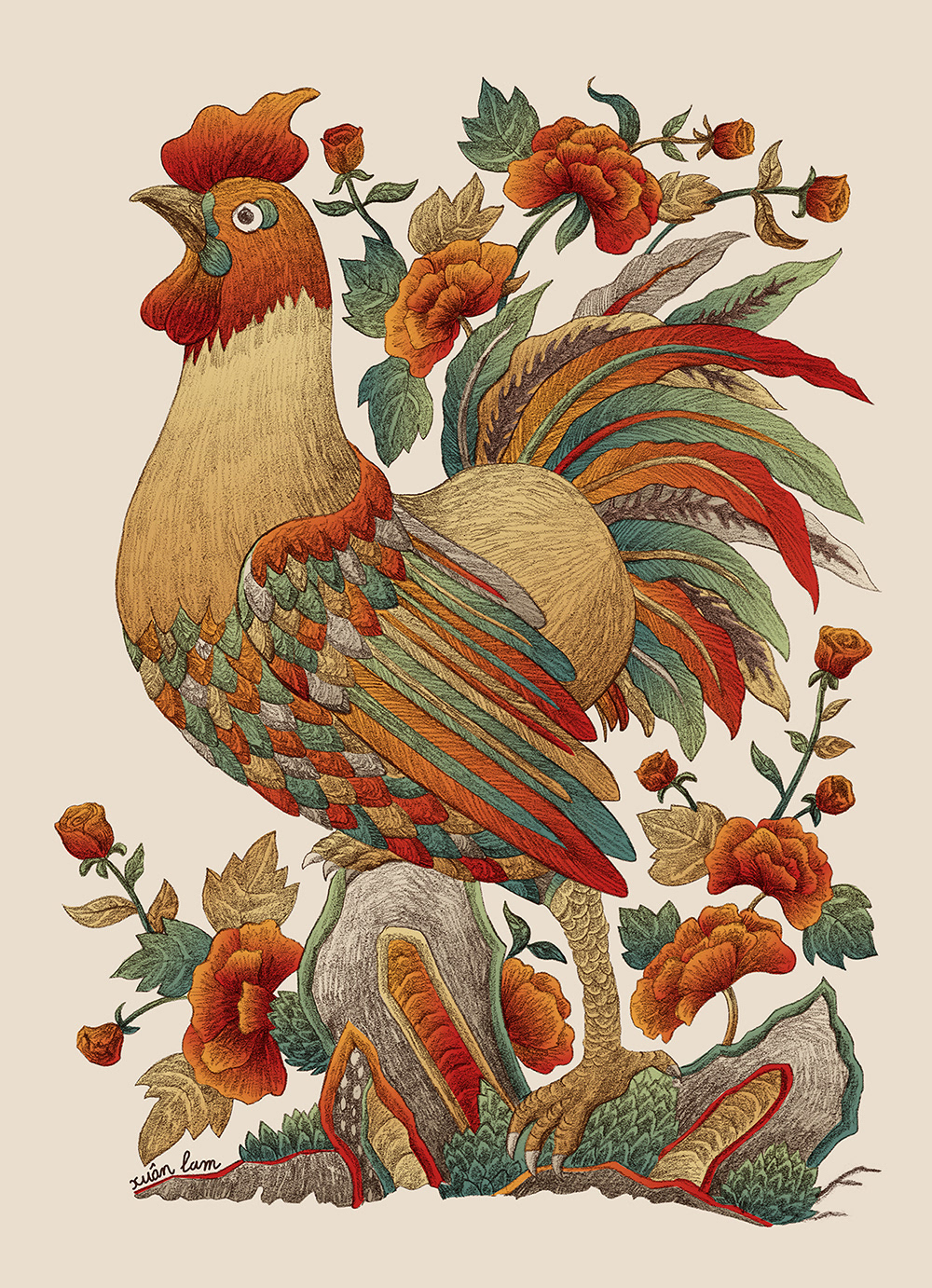
Rooster and Roses
By all accounts, the ancient Vietnamese associated the rooster with Five Virtues of a warrior: Literature – Martial Art – Bravery – Humaneness – Credibility. With the roses around, the painting symbolizes a rooster crowing to wake the Sun up, which is a sign of energy and good luck.
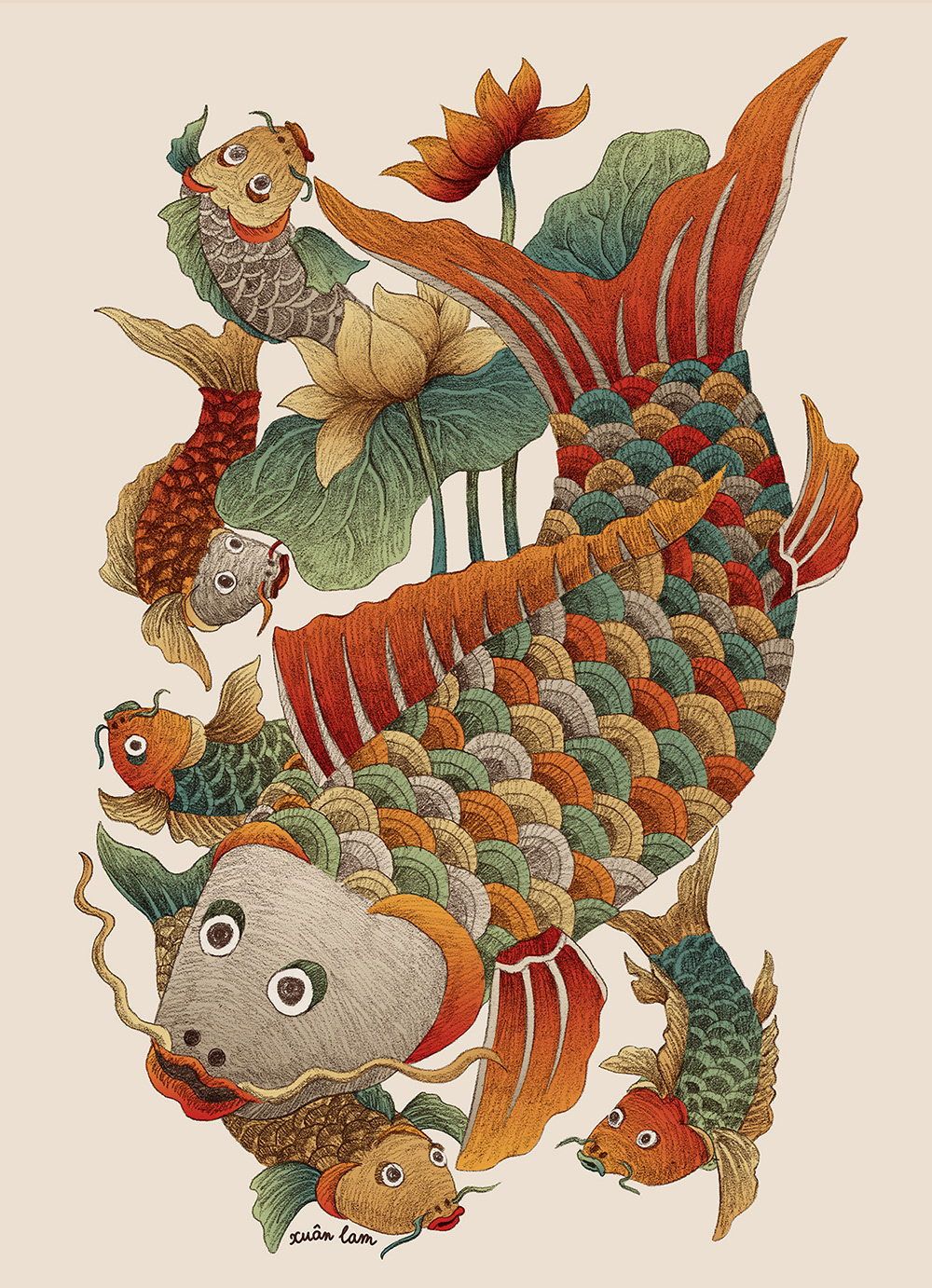
Carp
A popular painting during the Tet Holiday, which represents the wish of good luck and fortune. In the Oriental culture, legend has it that carp are capable of jumping over the Dragon Gate to transform into dragons. Thus, carp is a symbol of supreme effort, fortune, success and hope. Every year, on the 23rd of December in the Lunar Calendar, the Kitchen God rides the carp to return to Heaven to report the activities of every household to the Jade Emperor.
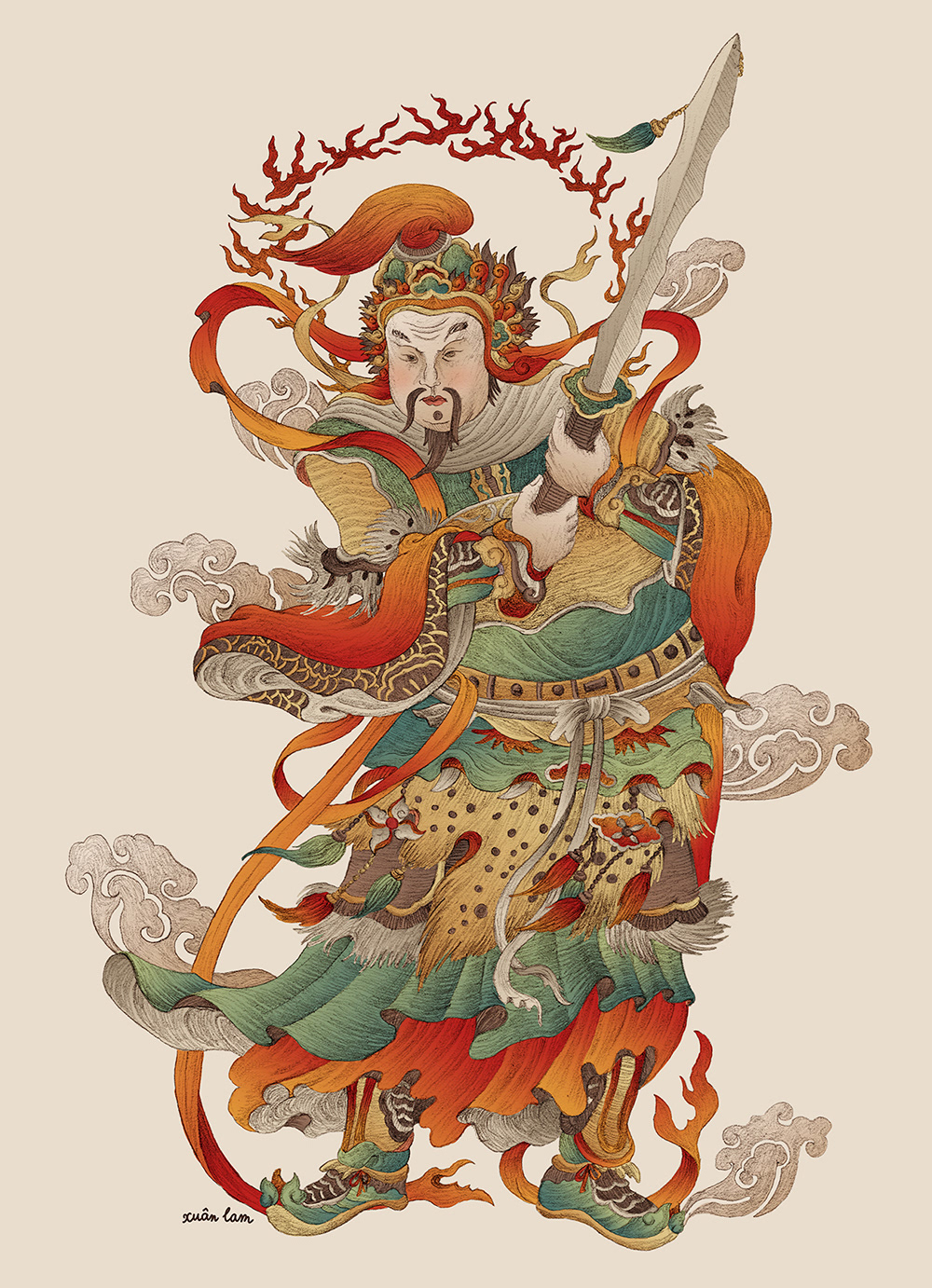
Military Mandarin
In each dynasty, if the literature mandarins are those who develop exceptional talent for literature and poetry and strategic planning, military mandarin are those who are masters at martial arts with great military leadership on the battlefields. The painting features the military mandarin with an imposing and august posture, reminding us of a Dharmapāla (Defender of the Law) in Buddhism.
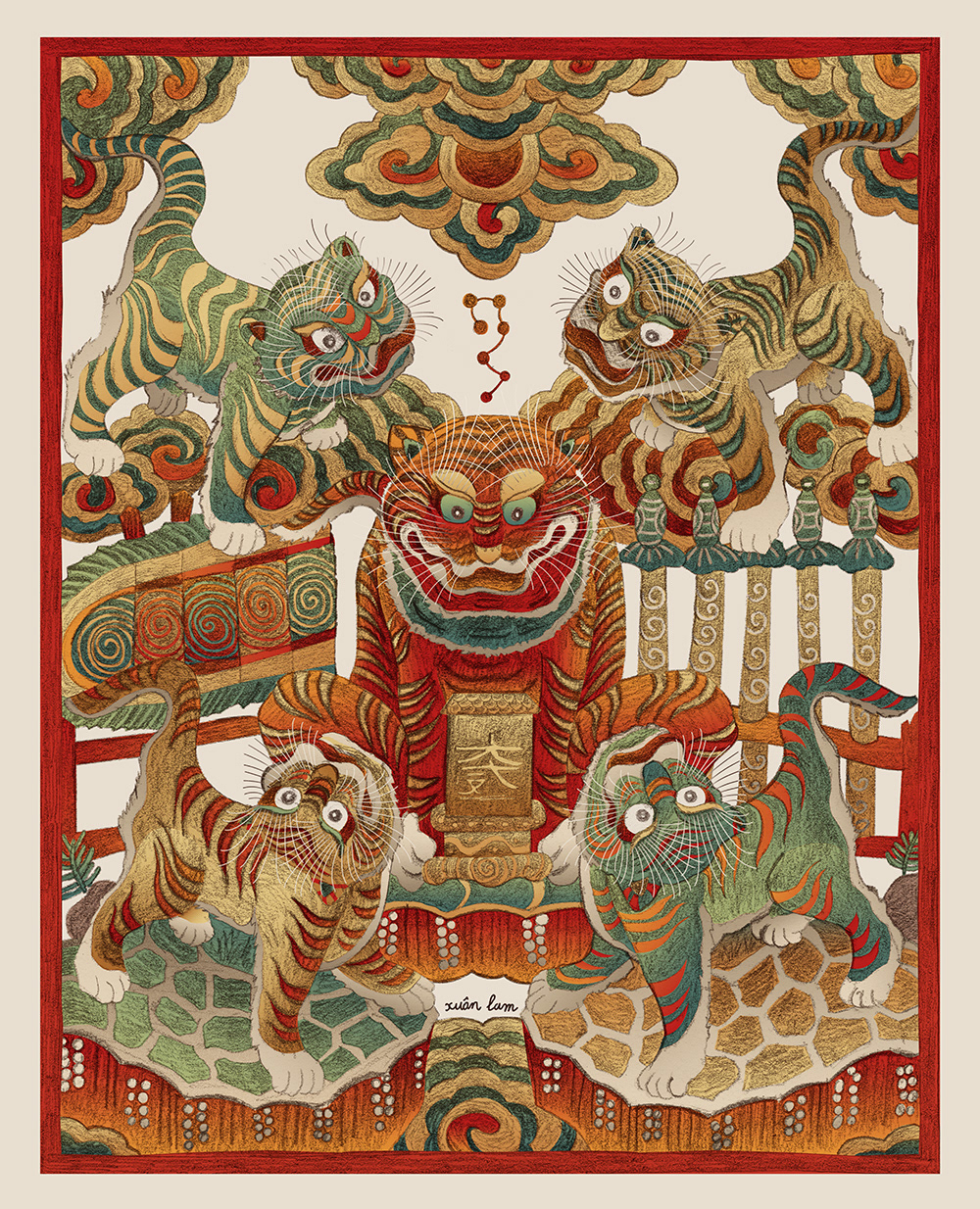
Five Tigers
According to Vietnamese religious belief, tiger possesses a sacred power to keep the ghosts away. In many ancient families, there were altars specially designed to worship the tiger, with the “Five Tiger” painting hung above. The painting features five tigers with a balanced structure, each tiger in a unique posture: one Is standing, one is sitting, another is riding the cloud and wind, … The structure, together with the strokes and colors, effectively depicts the vigorous and mighty air of the king of the forest.

Red Tiger
The painting features one of the Five Tigers with red color, representing the Fire in Five Elements and standing for the South. Besides the application of Five Elements, what makes this painting distinctive is the figure of the tiger with a strong body, an imposing posture and vibrant eyes.
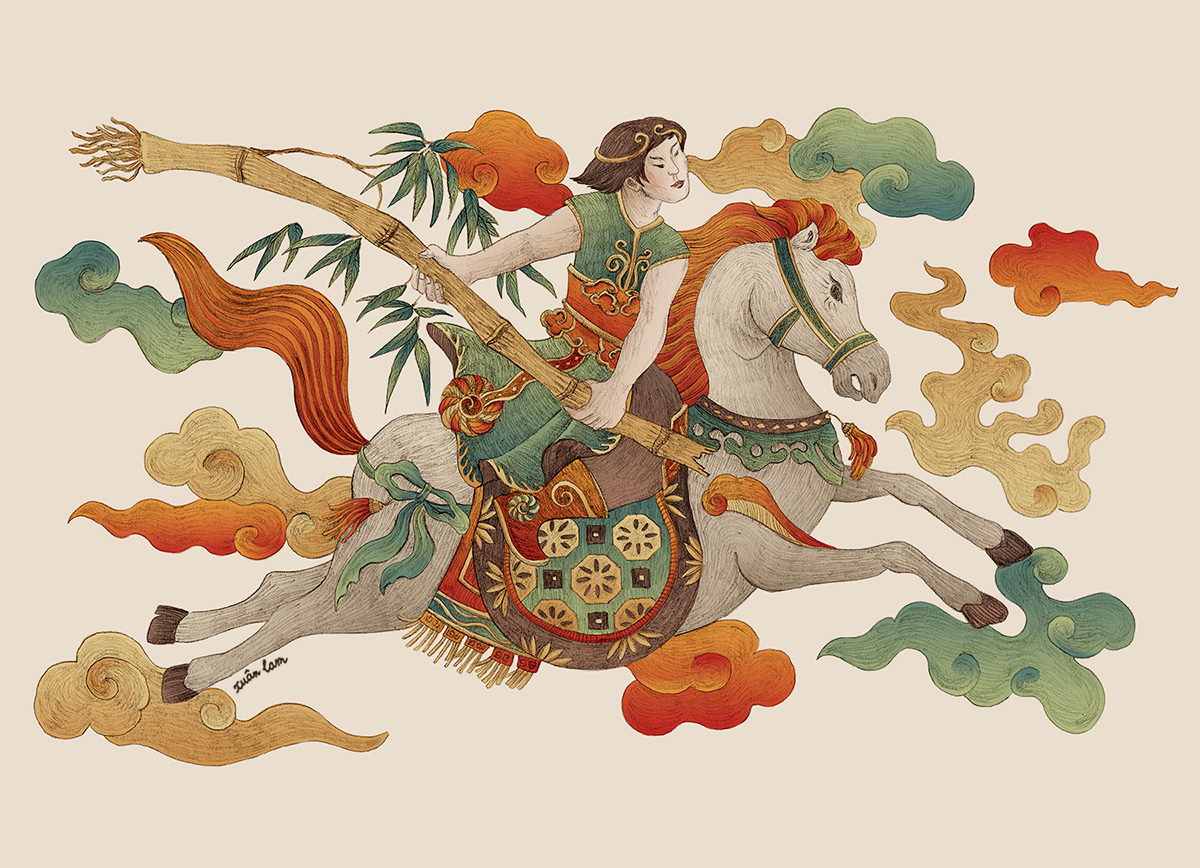
Thánh Gióng
Thánh Gióng (Phù Đổng Thiên Vương), is a mythical folk hero of Vietnam’s history and one of the Four Immortals. He is regarded as a symbol of patriotism and youthful vigor.
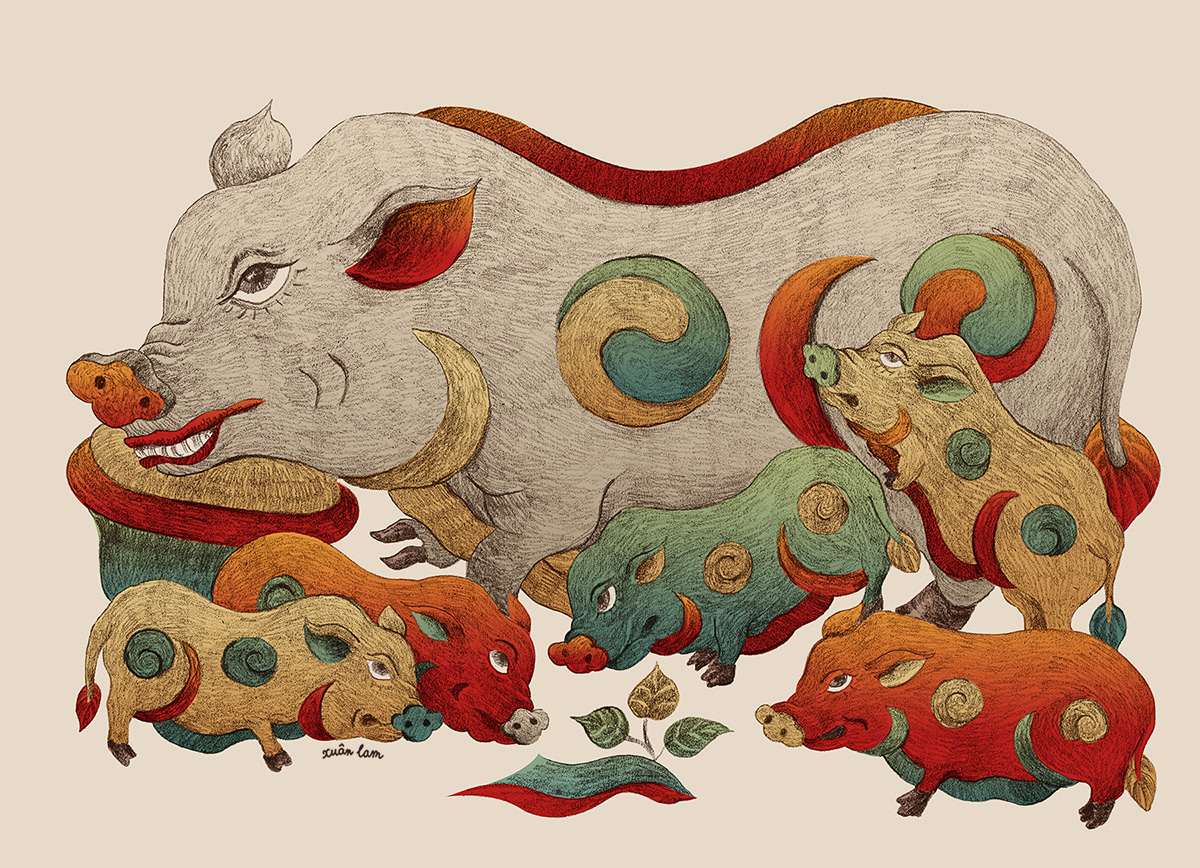
The drift of pigs
The painting features a litter of piglets surrounding a corpulent pig, which stands for the dream of a prosperous, peaceful and fruitful life. It is often presented to the newlyweds in the hope that they will soon have babies.
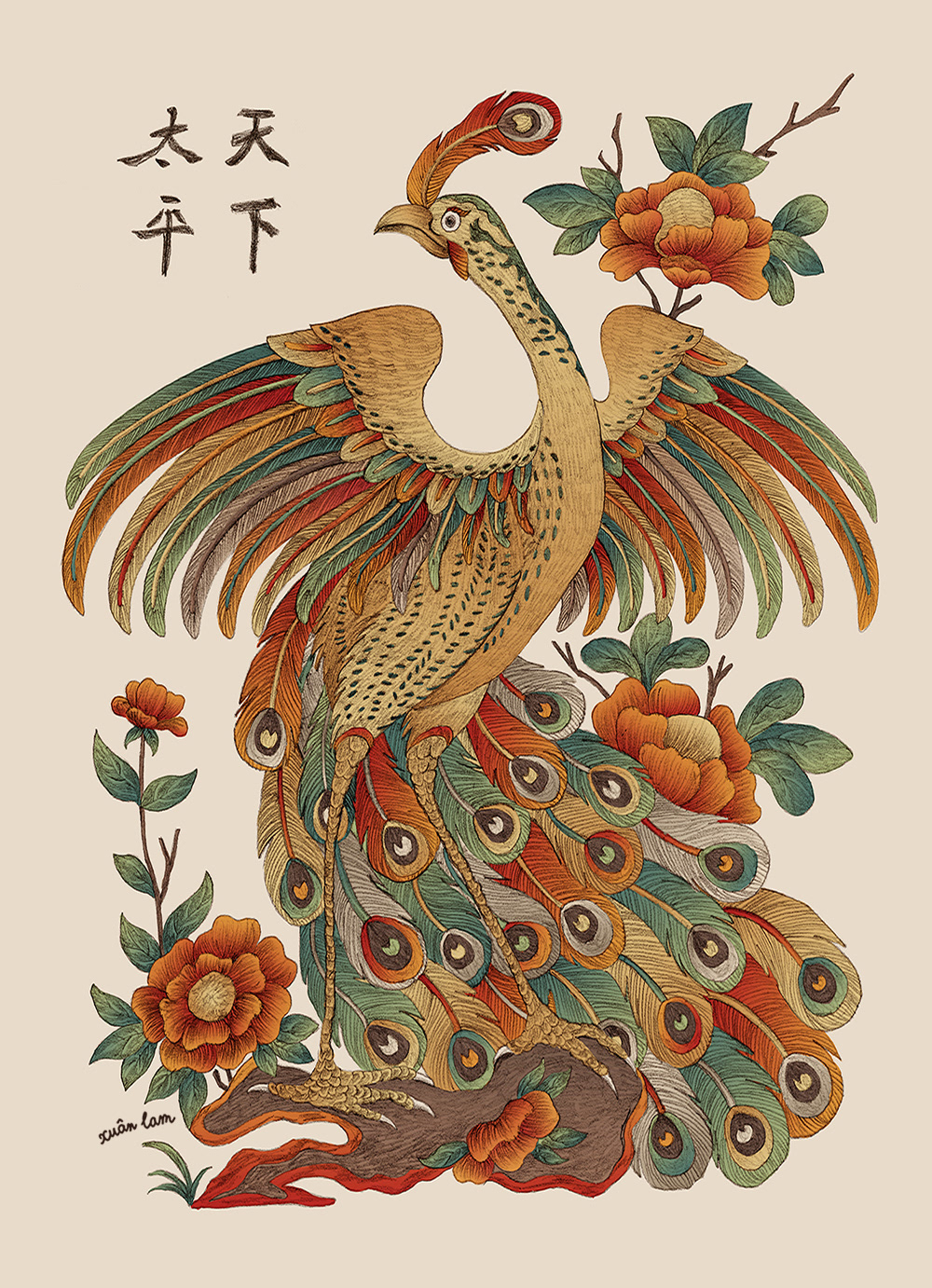
Peaceful world
The painting, named after the letters printed on it, features a peacock, which is alleged to embody the aesthetic values and prestigious virtues. Besides, during Tet holiday, the painting of a peacock is also believed to keep the ghosts away from the family.
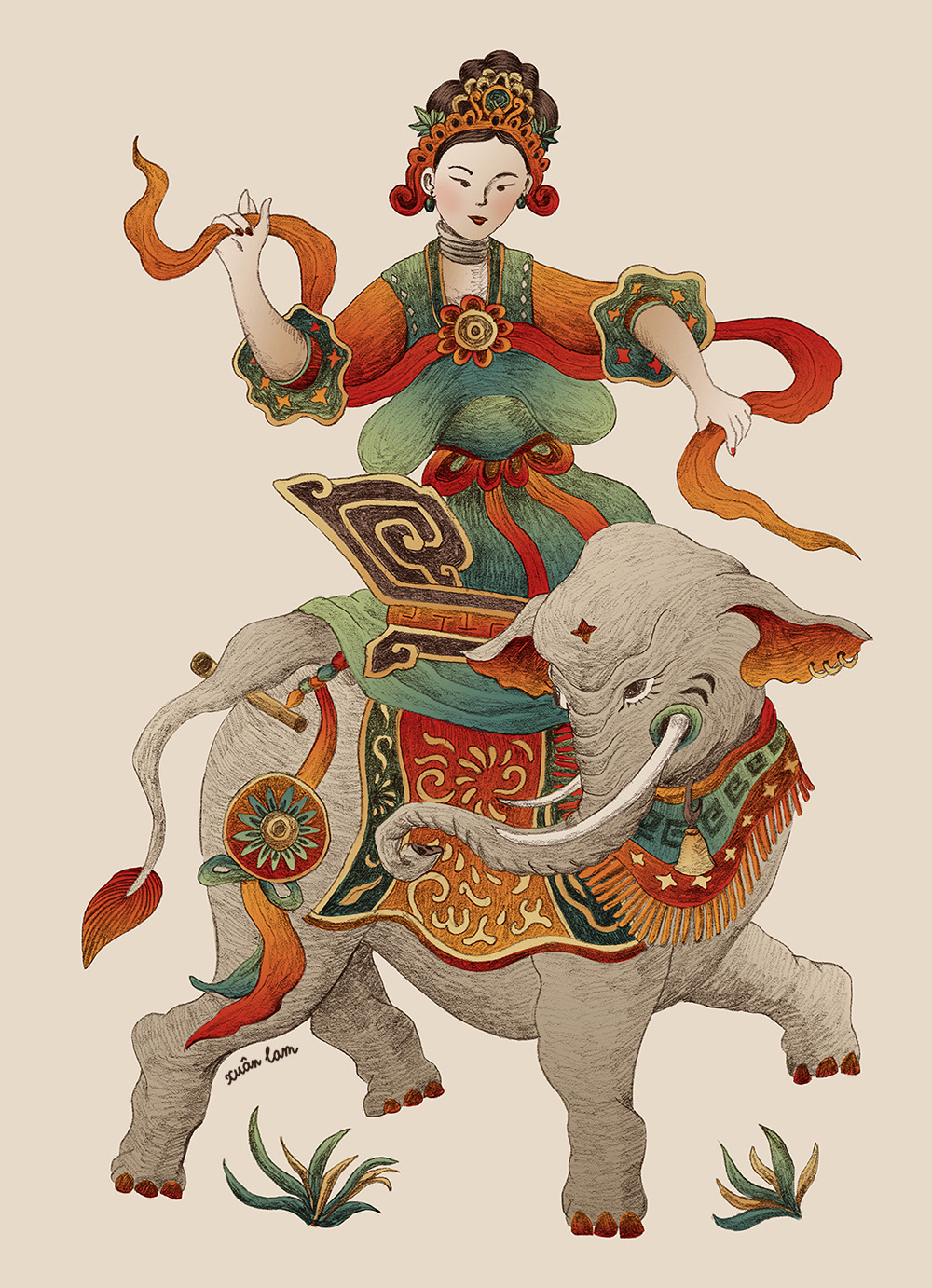
Lady Triệu
Lady Triệu (225 – 248), also known as Triệu Ẩu, Triệu Trinh Nương, was a female warrior in the 3rd century. She went down in history as a great heroine, a brave commander who kept fighting for the national sovereignty. She is quoted as saying, “I would like to ride storms, kill sharks in the open sea, drive out the aggressors, reconquer the country, undo the ties of serfdom, and never bend my back to be the concubine of whatever man."
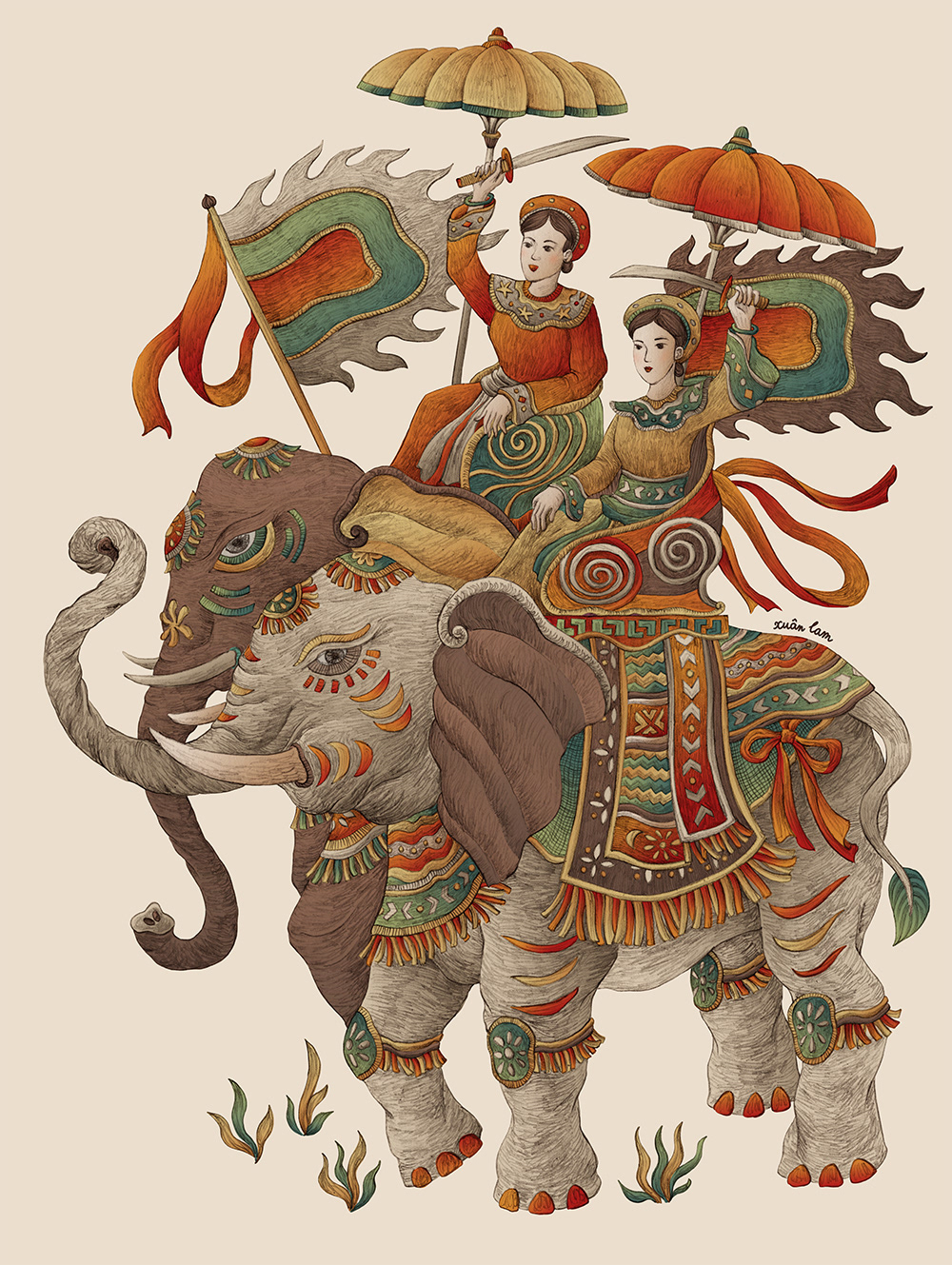
Lady Triệu
Lady Triệu (225 – 248), also known as Triệu Ẩu, Triệu Trinh Nương, was a female warrior in the 3rd century. She went down in history as a great heroine, a brave commander who kept fighting for the national sovereignty. She is quoted as saying, “I would like to ride storms, kill sharks in the open sea, drive out the aggressors, reconquer the country, undo the ties of serfdom, and never bend my back to be the concubine of whatever man."
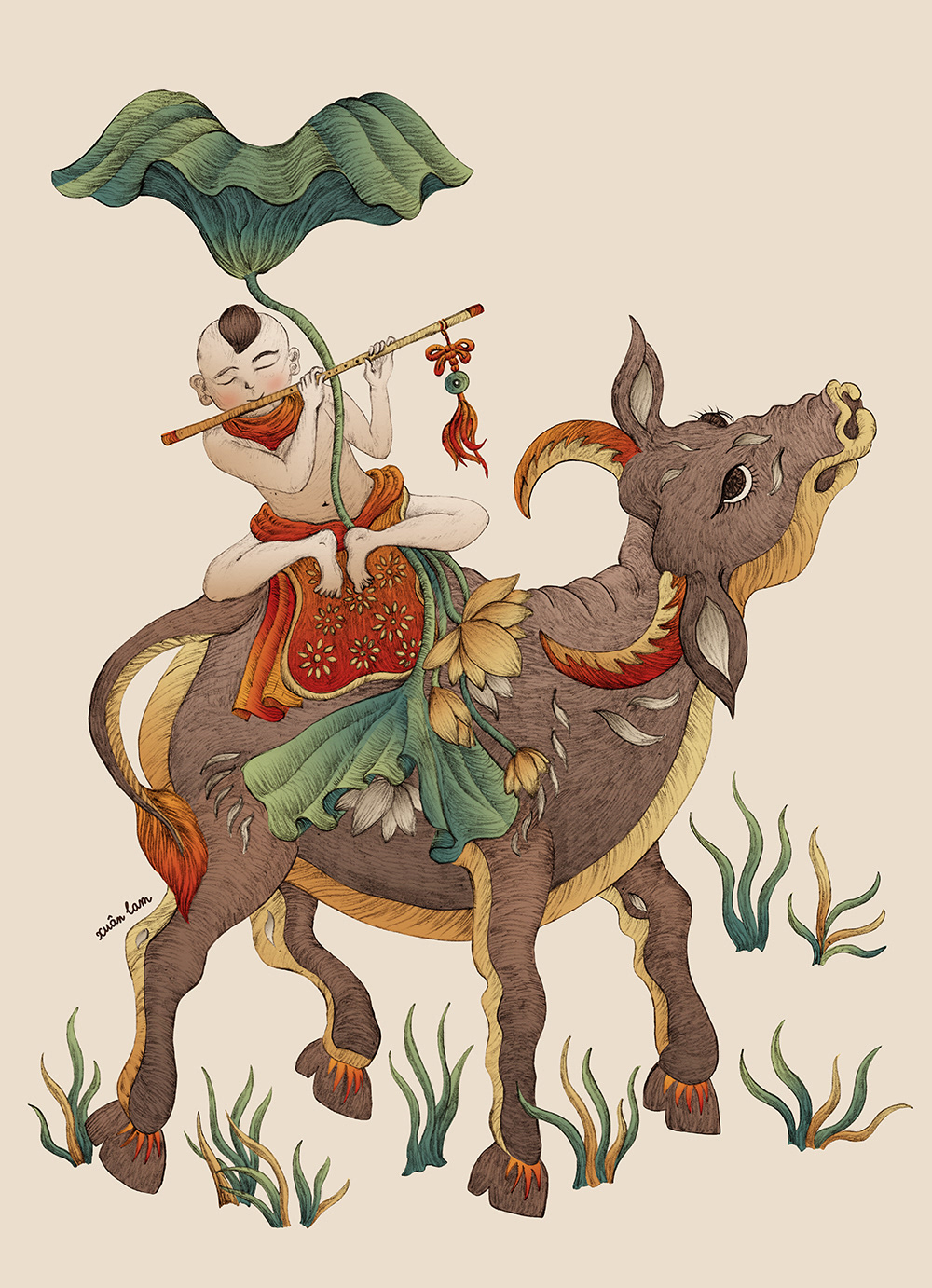
Lady Triệu
Lady Triệu (225 – 248), also known as Triệu Ẩu, Triệu Trinh Nương, was a female warrior in the 3rd century. She went down in history as a great heroine, a brave commander who kept fighting for the national sovereignty. She is quoted as saying, “I would like to ride storms, kill sharks in the open sea, drive out the aggressors, reconquer the country, undo the ties of serfdom, and never bend my back to be the concubine of whatever man."

Lady Triệu
Lady Triệu (225 – 248), also known as Triệu Ẩu, Triệu Trinh Nương, was a female warrior in the 3rd century. She went down in history as a great heroine, a brave commander who kept fighting for the national sovereignty. She is quoted as saying, “I would like to ride storms, kill sharks in the open sea, drive out the aggressors, reconquer the country, undo the ties of serfdom, and never bend my back to be the concubine of whatever man."
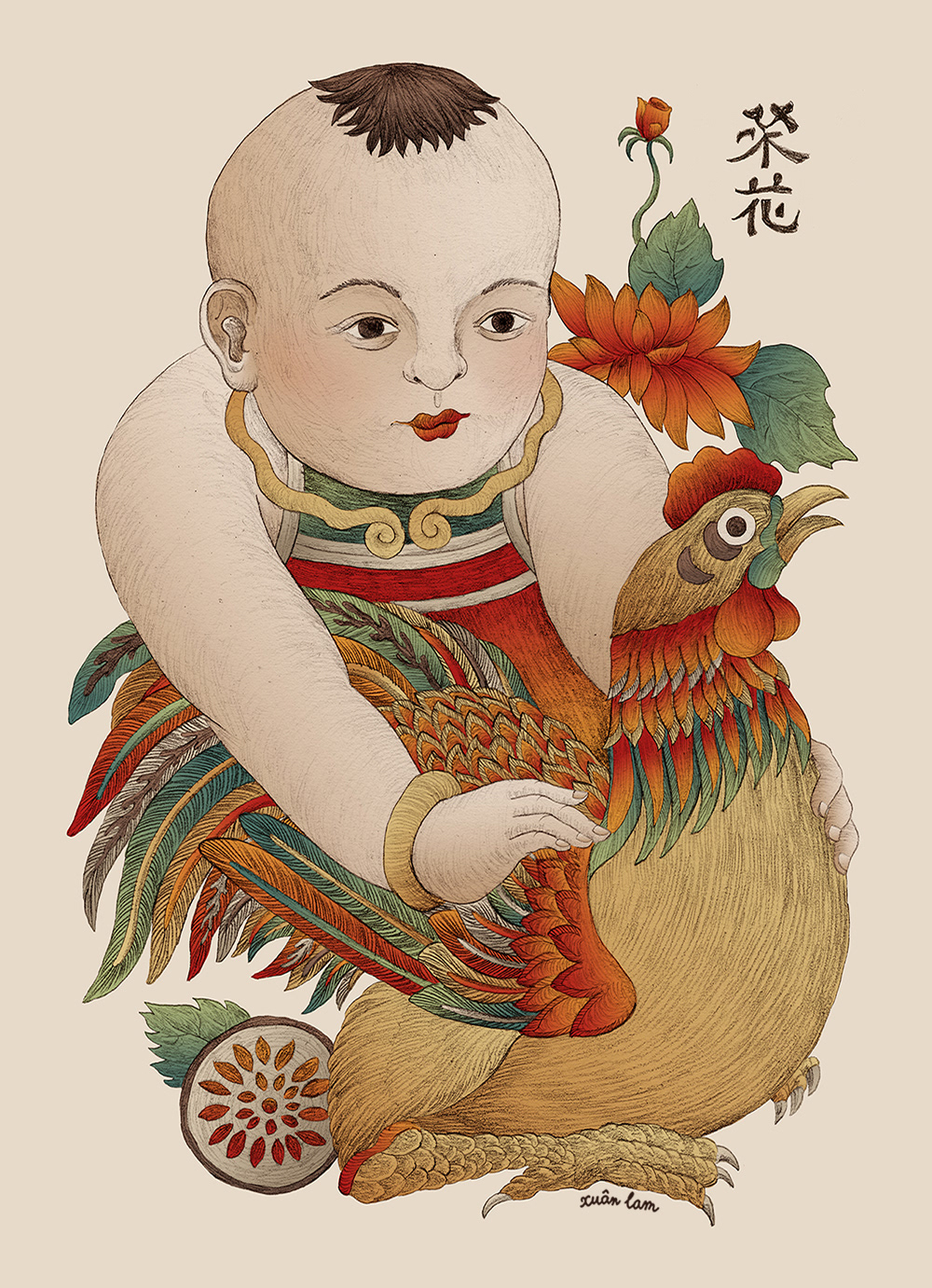
Eminence
The painting features a boy embracing a rooster, which represents the wish of good fortune and great success. In traditional Chinese, “a big rooster” and “great fortune” are homophones.

Lady Triệu
Lady Triệu (225 – 248), also known as Triệu Ẩu, Triệu Trinh Nương, was a female warrior in the 3rd century. She went down in history as a great heroine, a brave commander who kept fighting for the national sovereignty. She is quoted as saying, “I would like to ride storms, kill sharks in the open sea, drive out the aggressors, reconquer the country, undo the ties of serfdom, and never bend my back to be the concubine of whatever man."
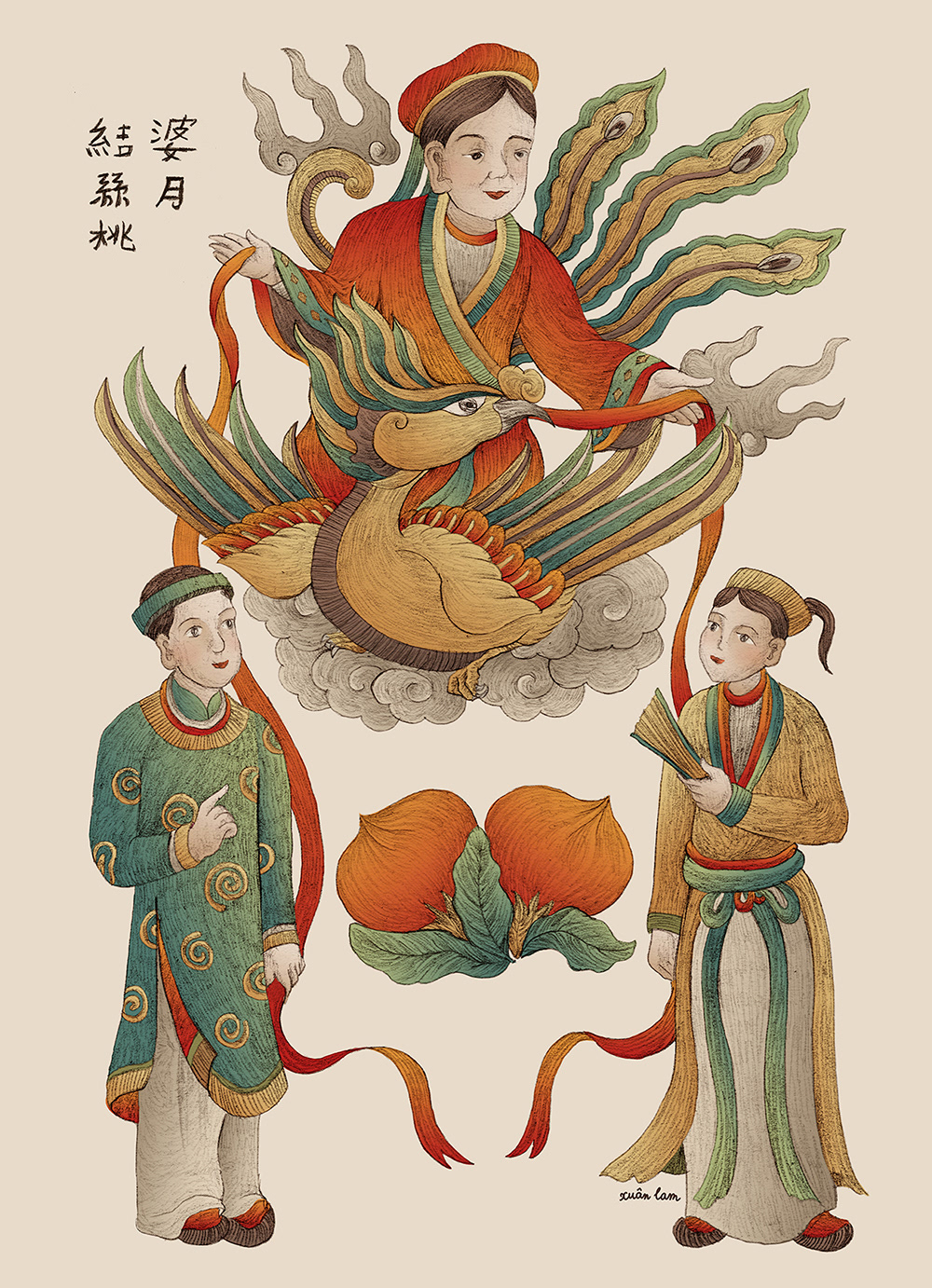
Yue Lao
Yue Lao (The Matchmaker Deity) is a god of marriage and love in the mythology. She is supposed to unite with a silken cord all predestined couples, after which nothing can prevent their union. In the painting, Yue Lao, riding a phoenix, is tying the couple with a red cord, which represents the wish that the young boys and girls in the family with soon get married to their suitable partners and live happily ever after.

Vicious Gamecocks
The painting features a family of chickens, including a hen, a cock and a clutch of chicks. On the painting are the letters: “Abundant offspring – Like father like son.” The arrangement and structure of the hen and the cock make their roles in the family become more distinct. It portrays the happy and cozy ambiance of a large family.
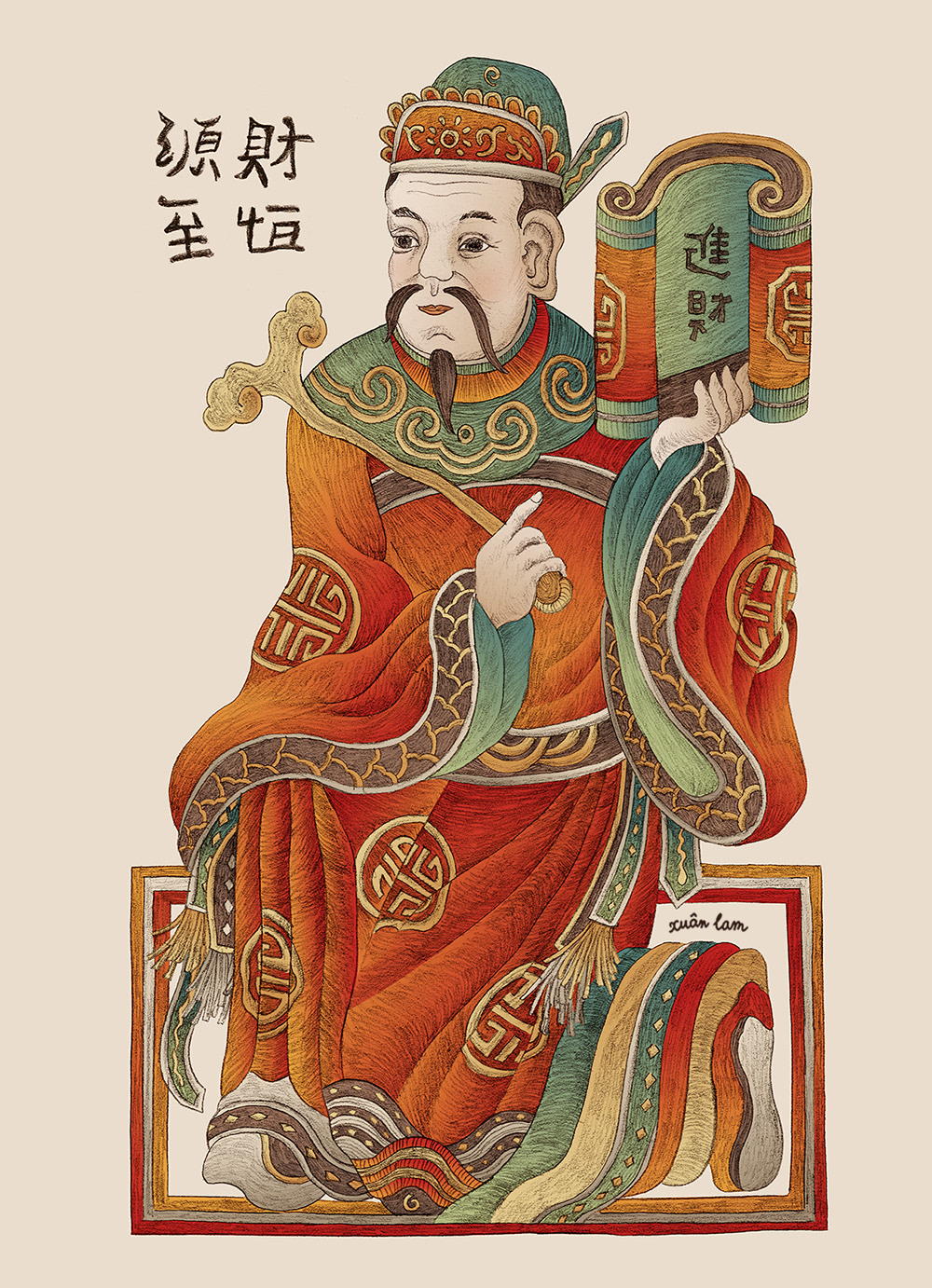
God of Wealth
The painting is often hung in front of the each house with a view to welcoming the wealth and prosperity home on the occasion of the Lunar New Year. In the painting, one hand of the God is holding the book – which represents the acquisition of knowledge, the other hand holding the scepter with the phrase: “The wealth comes as abundantly as the water.” That’s also the lifelong dream of all Vietnamese farmers.
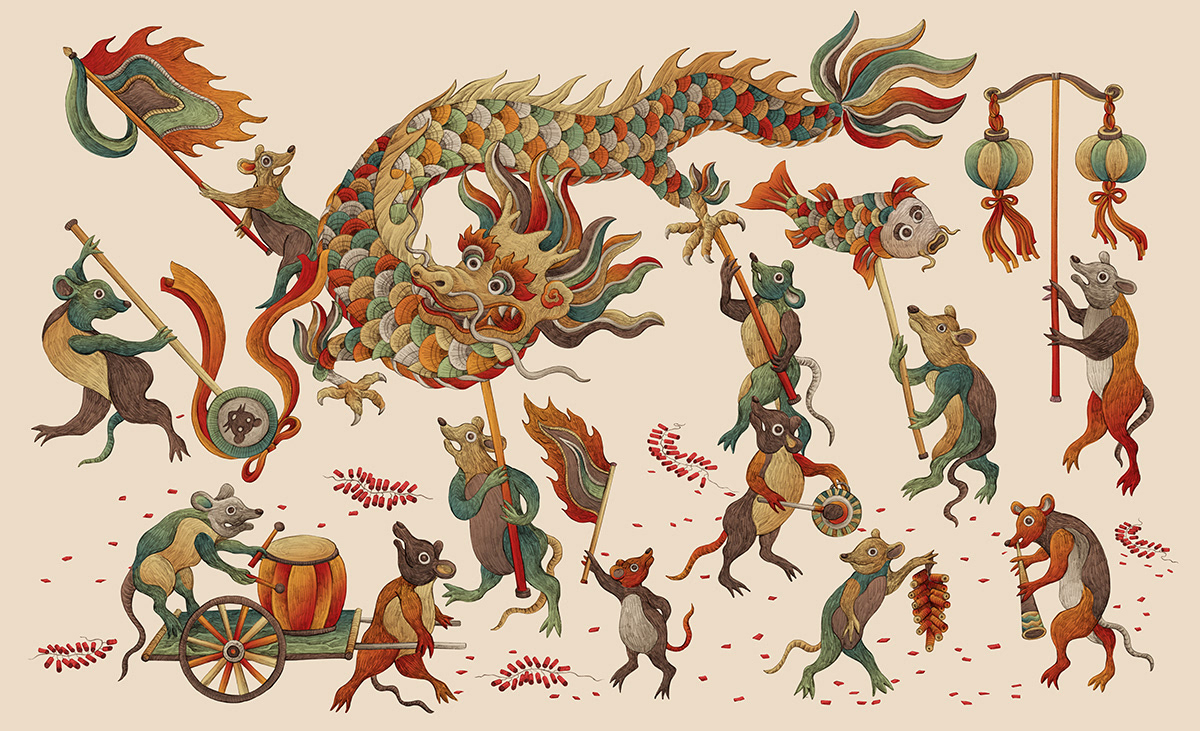
Lady Triệu
Lady Triệu (225 – 248), also known as Triệu Ẩu, Triệu Trinh Nương, was a female warrior in the 3rd century. She went down in history as a great heroine, a brave commander who kept fighting for the national sovereignty. She is quoted as saying, “I would like to ride storms, kill sharks in the open sea, drive out the aggressors, reconquer the country, undo the ties of serfdom, and never bend my back to be the concubine of whatever man."

Seven kids
This is one of the favorite paintings among the urban dwellers and often hung in each family on the occasion of the Lunar New Year. It is regarded as a wish for fertility and a prosperous life. The peach tree in blossom, together with seven chubby kids and bright colors, makes the painting both lively and luxurious.
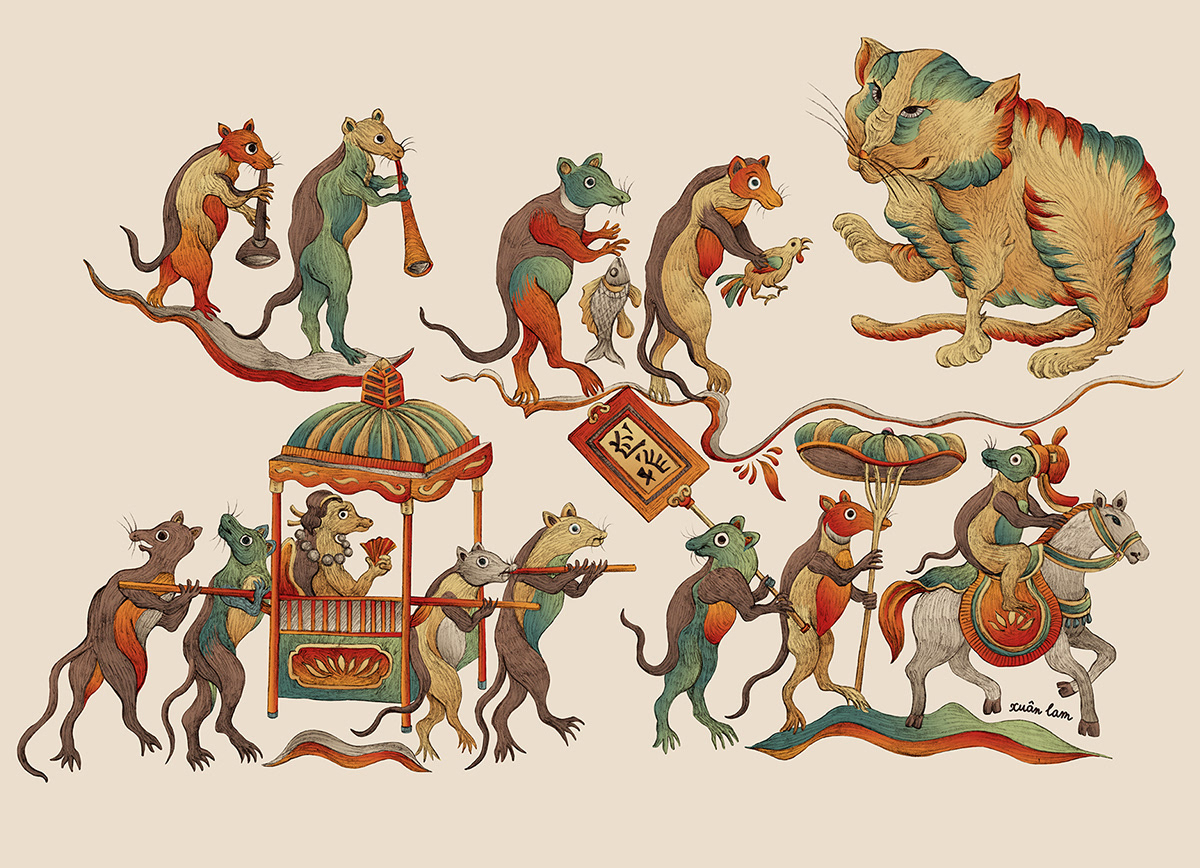
Lady Triệu
Lady Triệu (225 – 248), also known as Triệu Ẩu, Triệu Trinh Nương, was a female warrior in the 3rd century. She went down in history as a great heroine, a brave commander who kept fighting for the national sovereignty. She is quoted as saying, “I would like to ride storms, kill sharks in the open sea, drive out the aggressors, reconquer the country, undo the ties of serfdom, and never bend my back to be the concubine of whatever man."
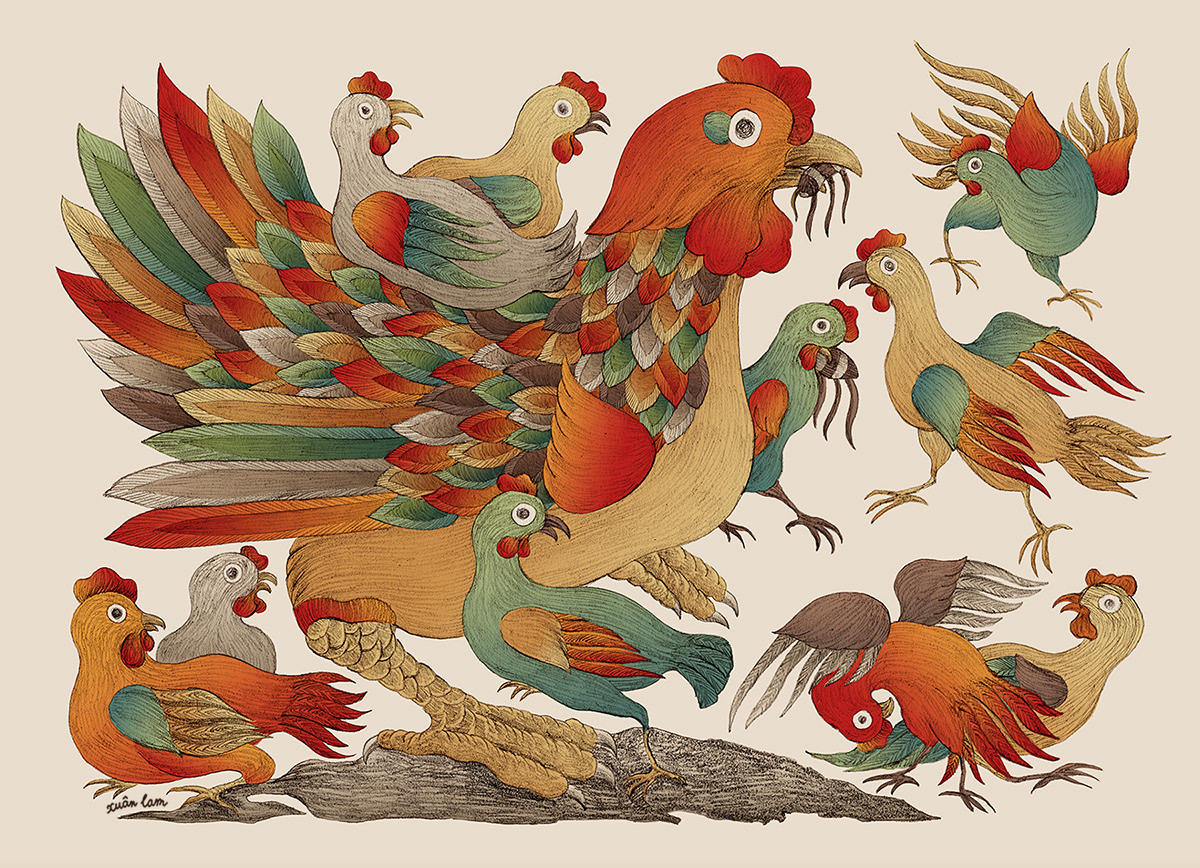
The clutch of chickens
The painting features a hen surrounded by ten baby chickens, each is different in the gesture and posture but all are very playful and energetic. The principal hue of the painting is made up of warm colors, making it brighter with a sky full of sunlight. The painting stands for the farmer’s dream of fertility and happy families.
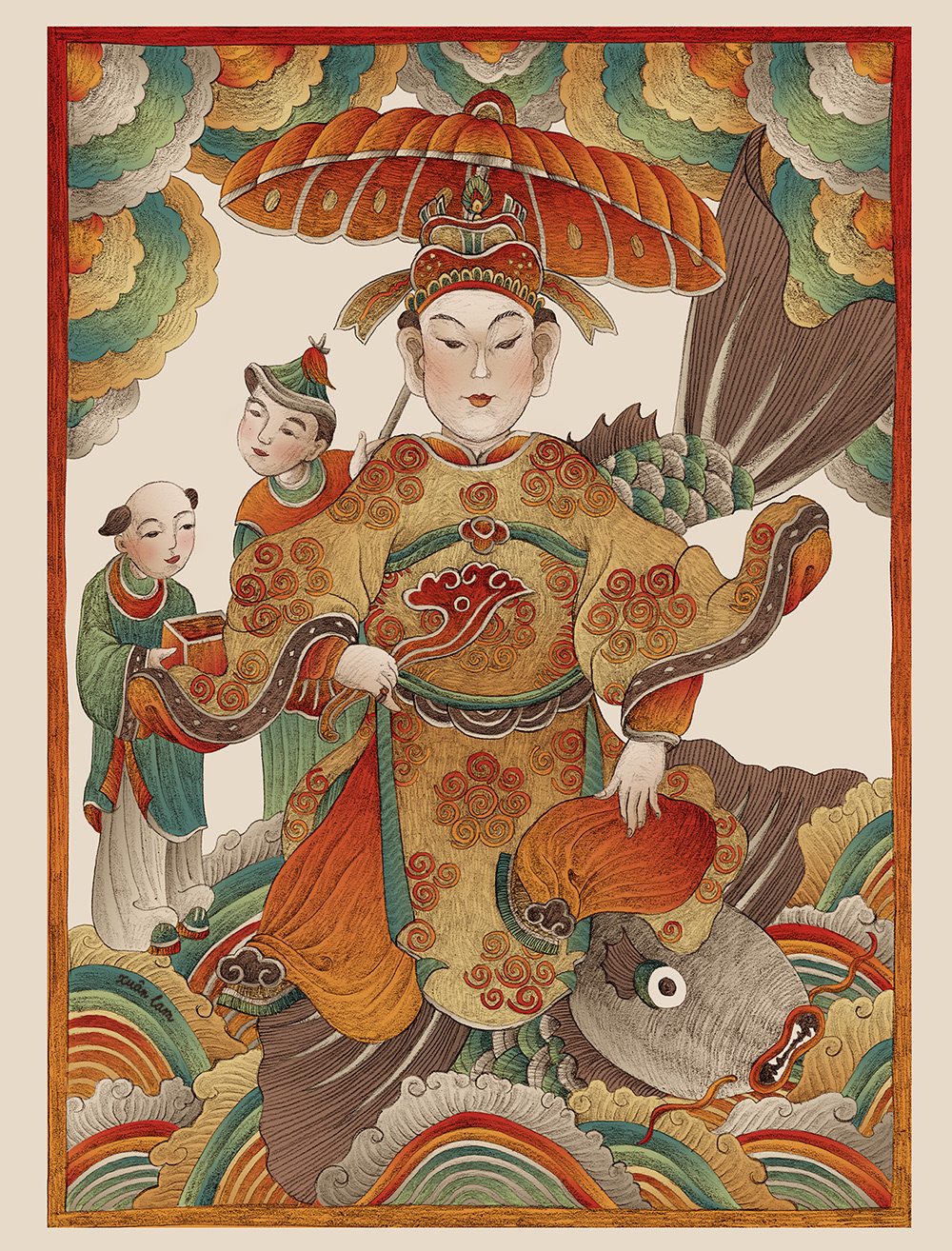
The Third Prince riding the fish
The painting features Ông Hoàng Bơ, one of the Four Emperors, the third son of Long Vương Bát Hải Động Đình. In the painting, the Prince has the graceful and ravishing appearance, wearing a white large-sleeved ceremonial robe and a wushamao (Ming official headwear), one hand holding the scepter, representing the royal power. Behind him are the servants holding the casket and parasol.
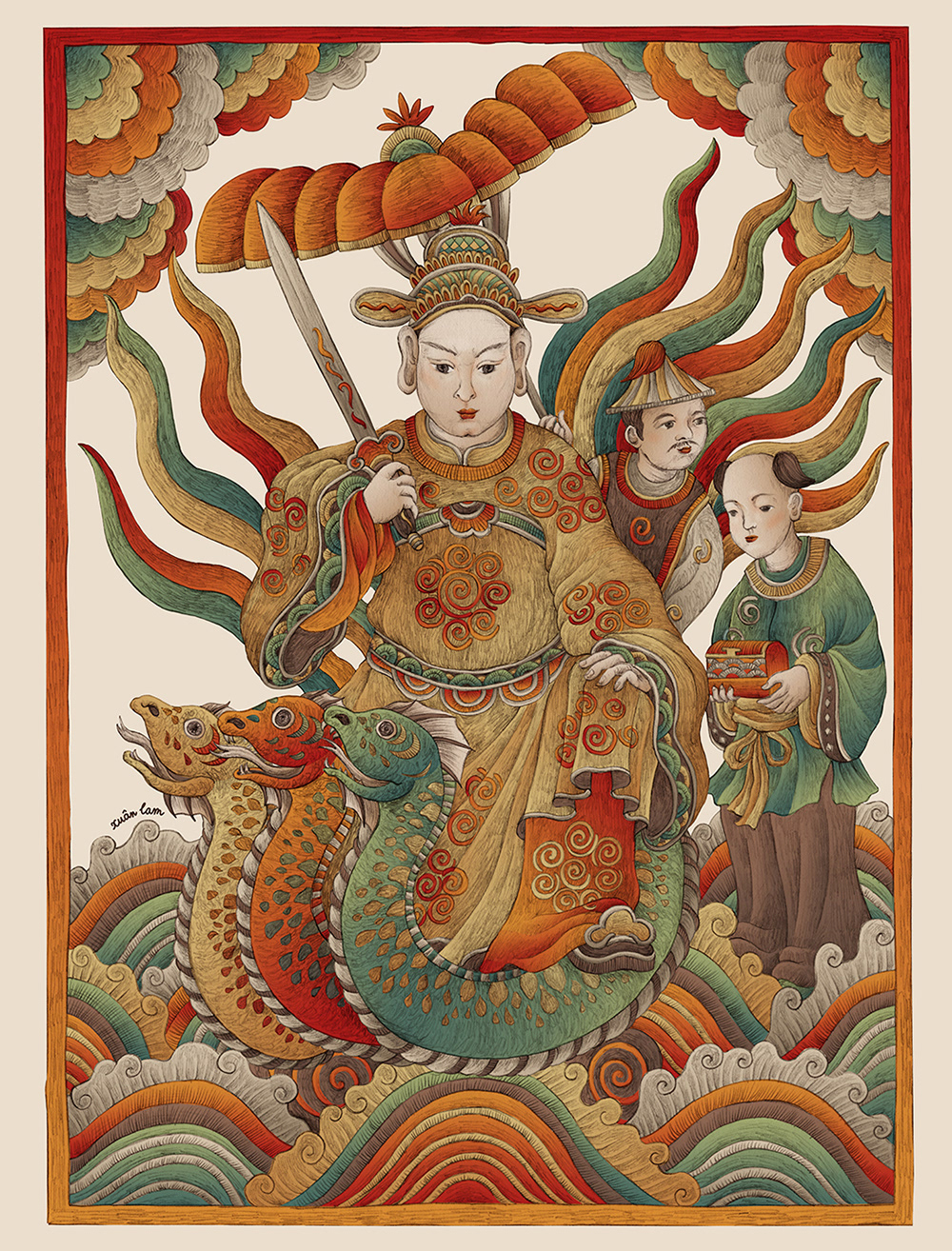
Lady Triệu
Lady Triệu (225 – 248), also known as Triệu Ẩu, Triệu Trinh Nương, was a female warrior in the 3rd century. She went down in history as a great heroine, a brave commander who kept fighting for the national sovereignty. She is quoted as saying, “I would like to ride storms, kill sharks in the open sea, drive out the aggressors, reconquer the country, undo the ties of serfdom, and never bend my back to be the concubine of whatever man."
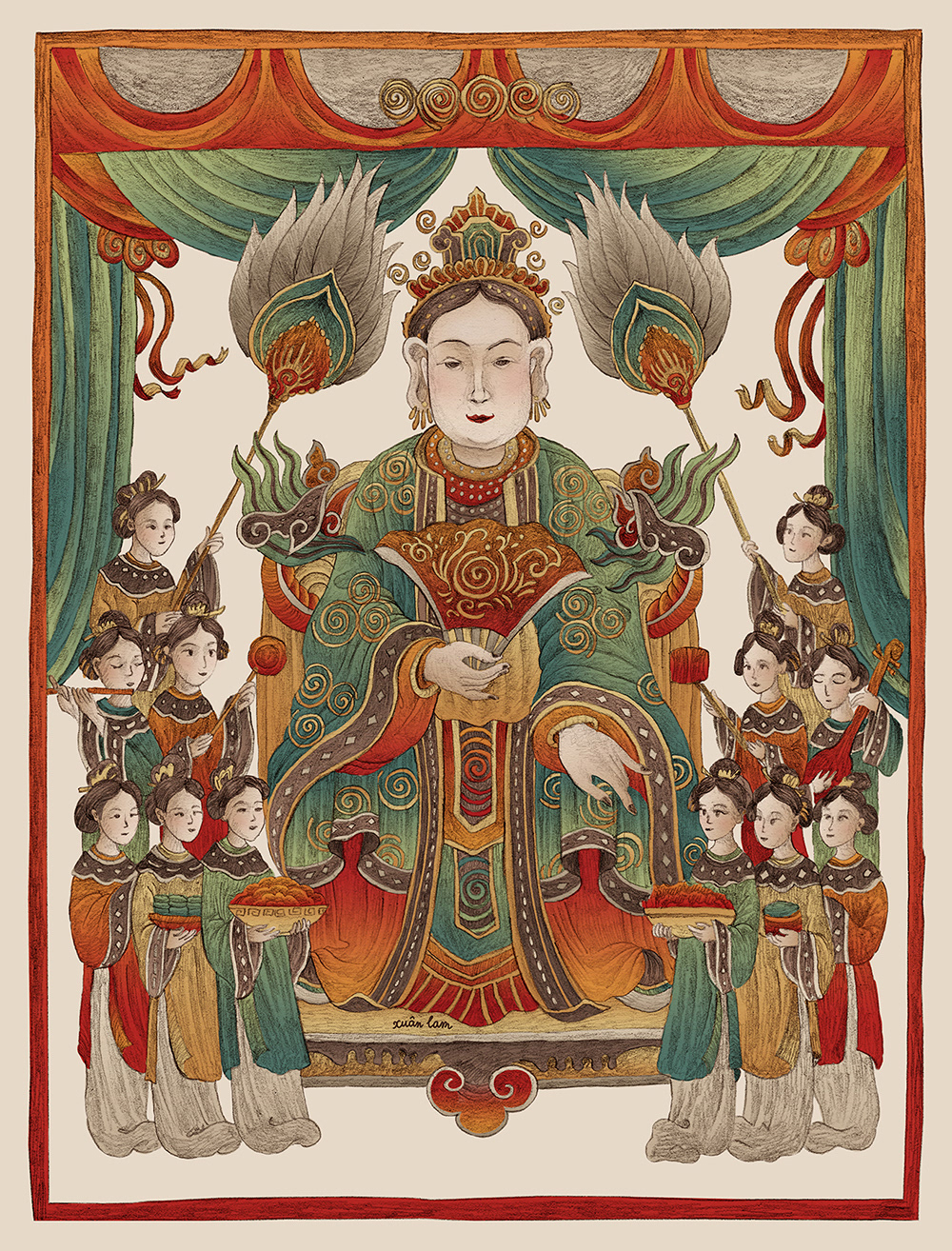
Princess of the Forest
Princess of the Forest is the ruler of the Forest Palace among the spirits of the Four Palaces in Vietnamese indigenous religion. Legend has it that Princess of the Forest was the daughter of prince Sơn Tinh and Mỵ Nương, King Hùng’s daughter.
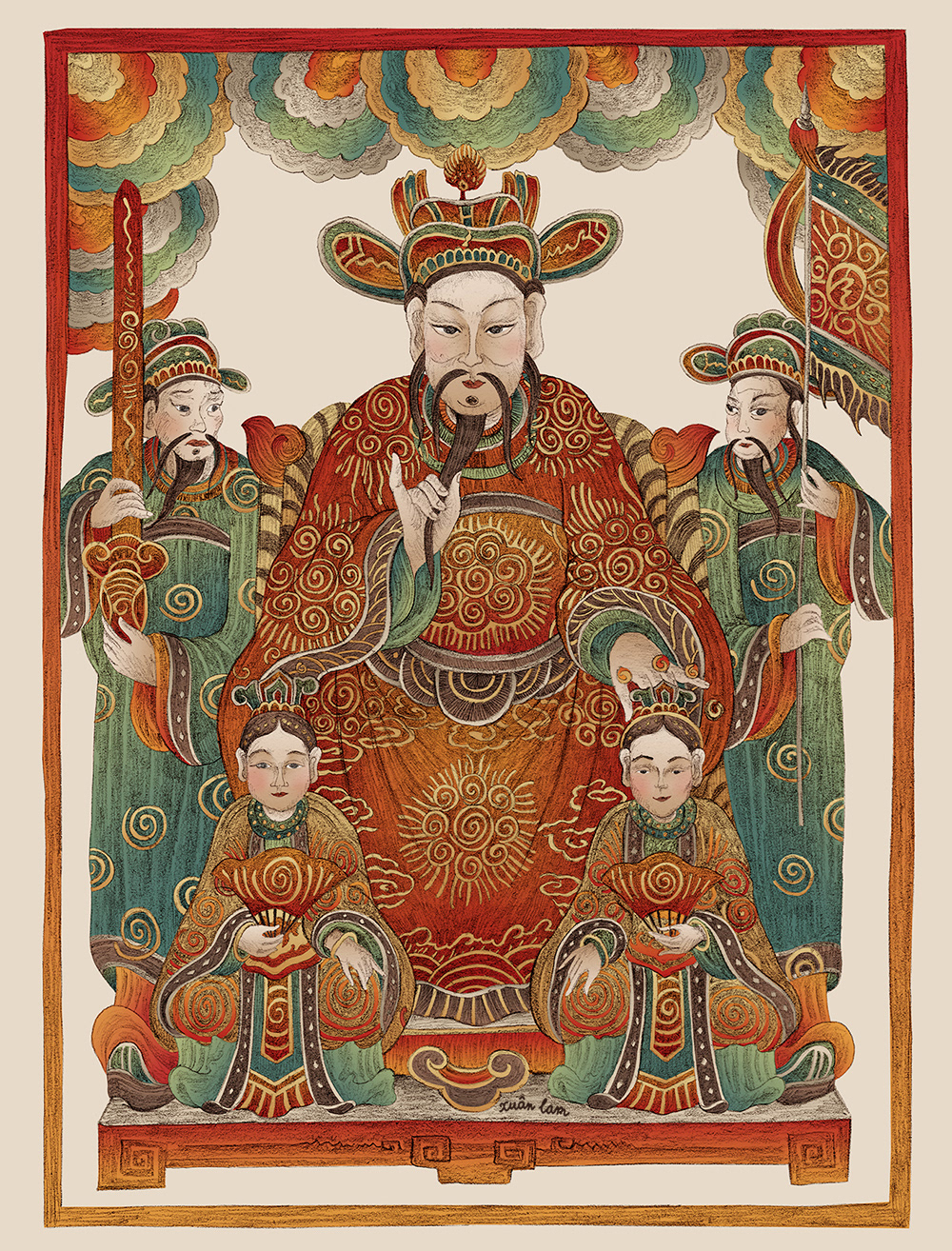
Duc Thanh Tran
Trần Hưng Đạo (1228 – 1300) was a politician, a writer, and the Supreme Commander of Vietnam during the Trần Dynasty. He is also regarded as on of the most accomplished military tacticians in Vietnam’s and the world’s history. He successfully commanded the Đại Việt armies that repelled three major Mongol invasions in the 13th century. In honor of his glorious achievements, he is reserved by the Vietnamese as a national hero with many shrines dedicated to him all over the country.
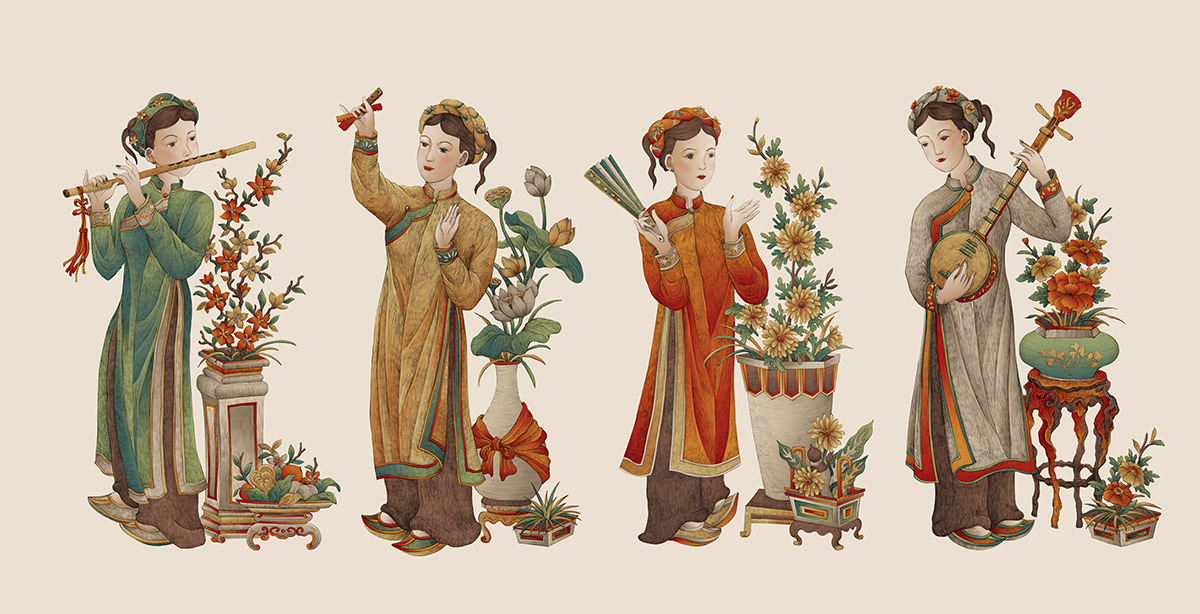
Lady Triệu
Lady Triệu (225 – 248), also known as Triệu Ẩu, Triệu Trinh Nương, was a female warrior in the 3rd century. She went down in history as a great heroine, a brave commander who kept fighting for the national sovereignty. She is quoted as saying, “I would like to ride storms, kill sharks in the open sea, drive out the aggressors, reconquer the country, undo the ties of serfdom, and never bend my back to be the concubine of whatever man."
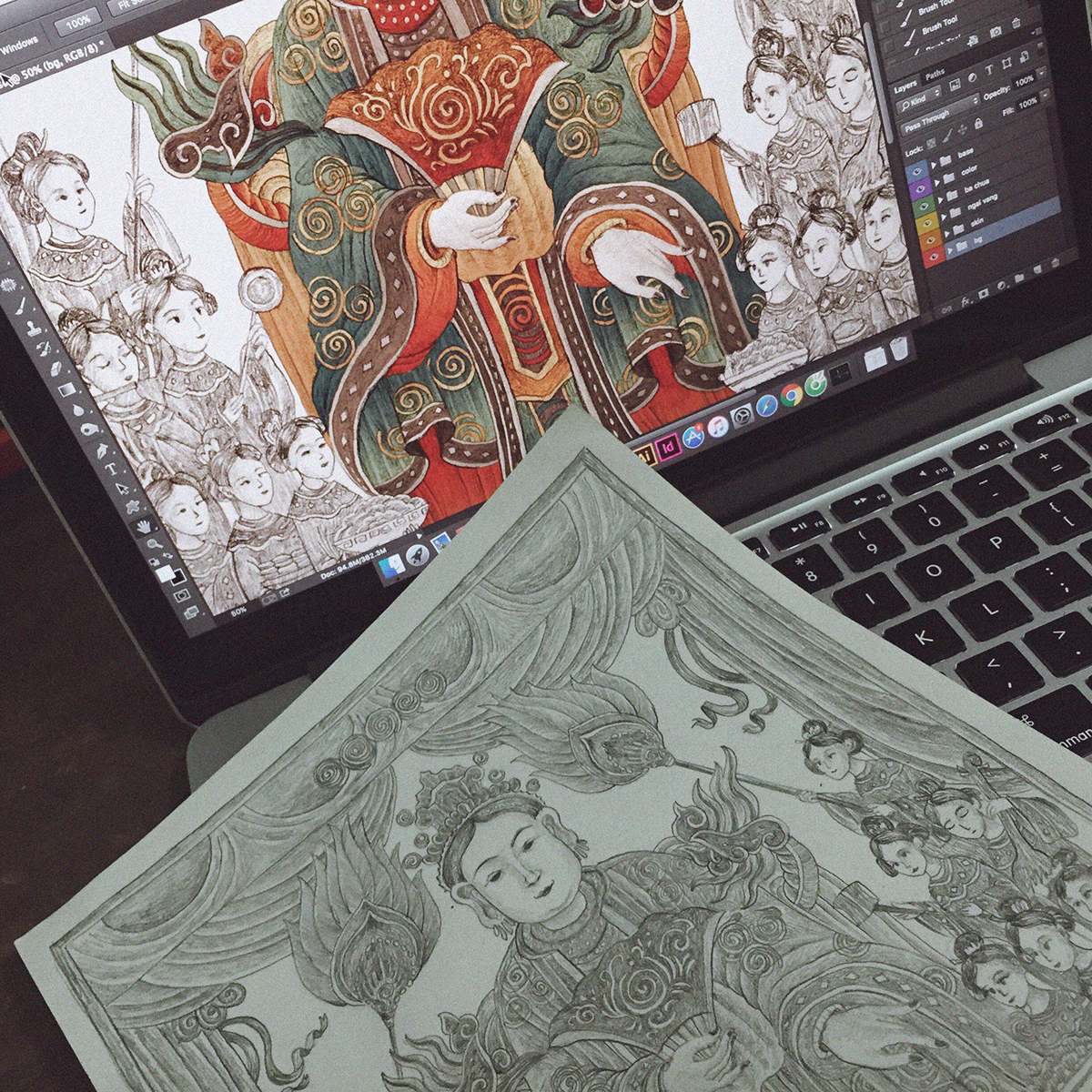
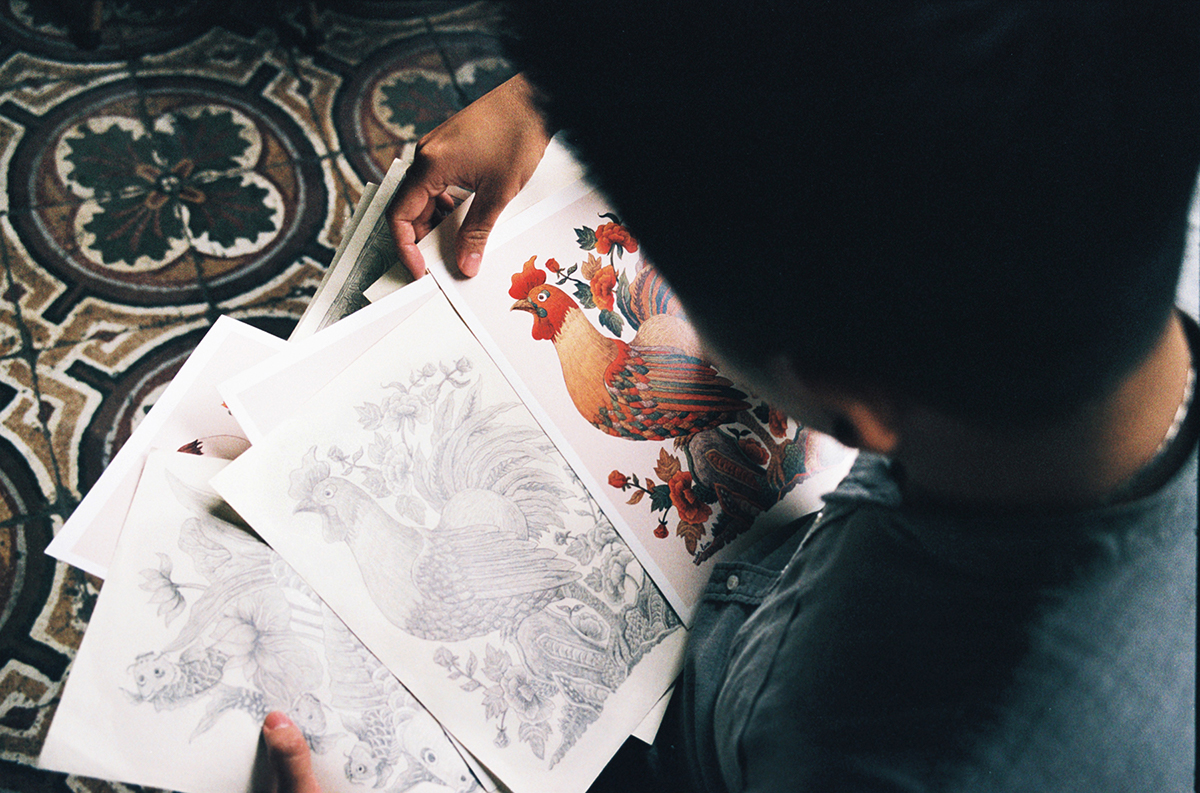
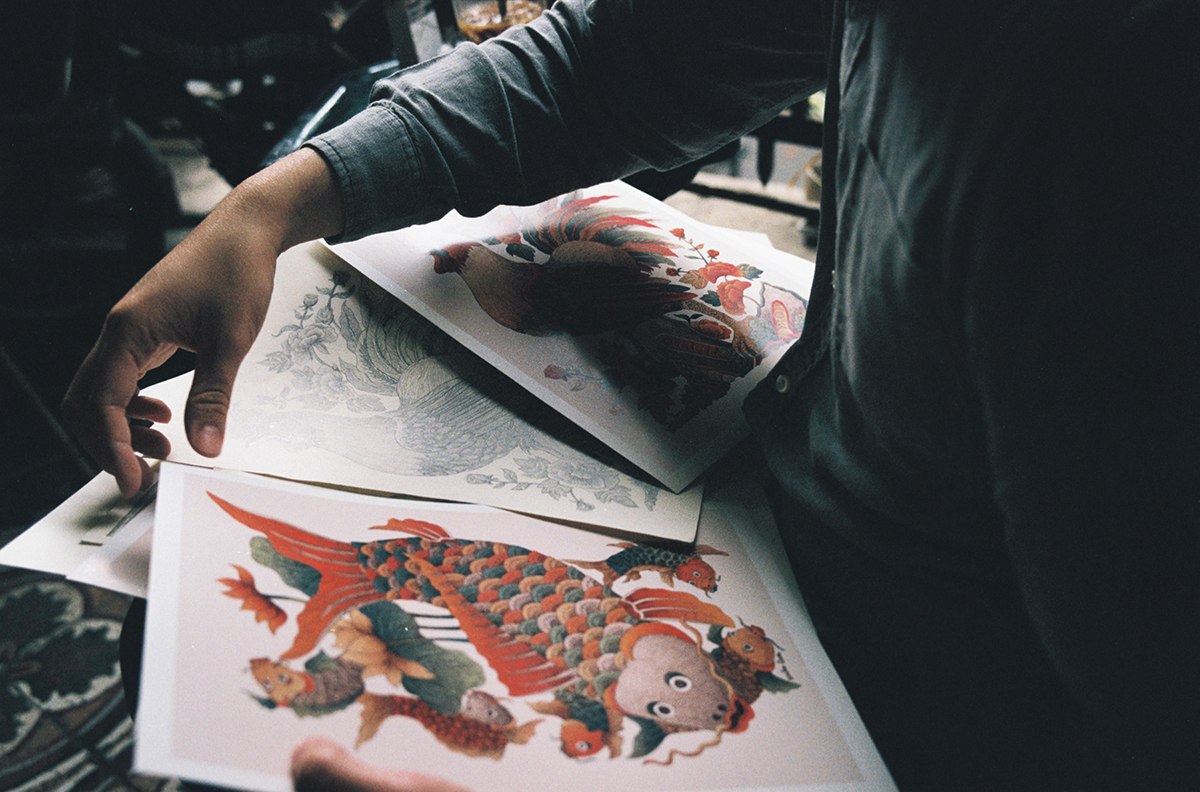

The products introduced in this project include tote bag, red envelope, notebook, calendar, bomber jacket and dress. Shout out to my friend Thanh Trung & Minh Ngọc for helping me doing this photoshoot, fashion designer Hoa Nguyen for making these beautiful dress & jacket. A collaboration of Hoodie and T-shirt between me and Tired City, a Hanoi-based brand specialized in art print with young local artists was made.
